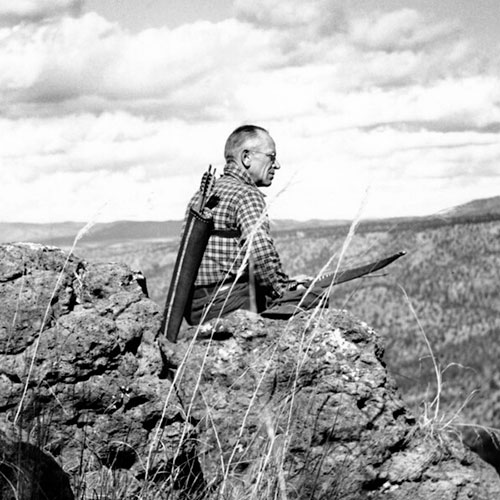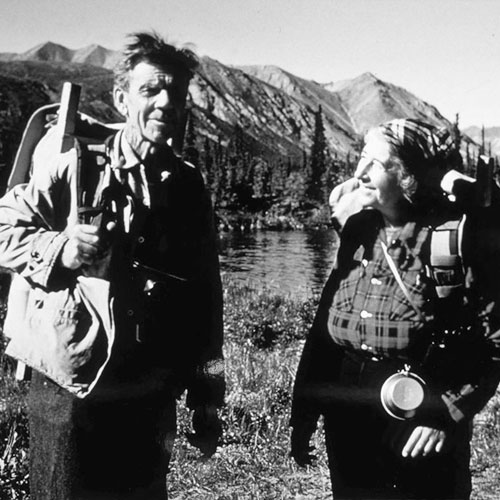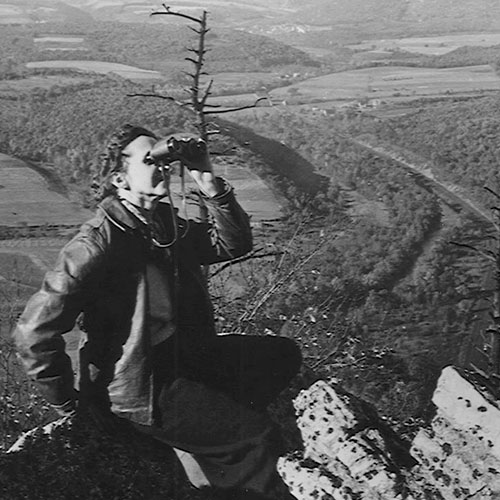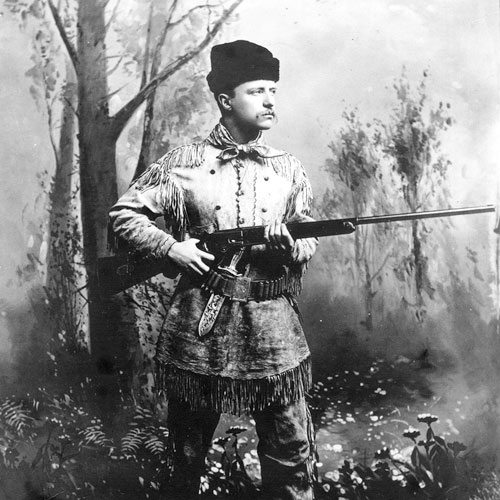Conservation Heroes
Some of our Greatest Conservationists
The conservation movement began in the United States with concerned sportsmen who realized that wanton waste of wildlife and their habitat had led to the decimation of many game species and even the extinction of some. The movement’s earliest champions included Theodore Roosevelt, who founded the Boone and Crockett Club, a hunting conservation organization, in 1887, and John Muir, who founded the Sierra Club five years later.
While there are many others who have gone on to shape the history of conservation in the United States, the five individuals highlighted above have made indelible marks on how we view the conservation of the land and its resources today. Click on each photo or name to visit a page dedicated to each conservationist, with text, video, photographs, and links to explore their lives and their work.
Conservation Heroes Hall Of Fame
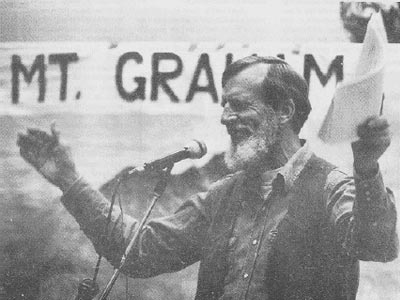 Edward Abbey
Edward Abbey
Edward Abbey 1927-1989
 “It is not enough to fight for the land; it is even more important to enjoy it, while you can, while it is still here.”
“It is not enough to fight for the land; it is even more important to enjoy it, while you can, while it is still here.”
Thus wrote Edward Abbey in his classic conservation text, Desert Solitaire.
Edward Abbey was a writer, environmentalist, and general anarchist that opposed human interference with nature. He bounced around many collegiate institutions. He even spent a year at Yale, which he chided for its Ivy League power structure. Abbey received a bachelor’s degree in philosophy from the University of New Mexico.
Though he hails from Pennsylvania, most of Abbey’s works took place in the Southwest; this is likely inspired by the two seasons in 1956 and 1957 that he spent as a Seasonal Ranger with the National Park Service at Arches National Park in Utah. His writings combined the sensitivity of the poet with the curmudgeon’s stinging wit, while conveying a deep love for wilderness. His 1976 fictional comic novel, The Monkey Wrench Gang, inspired a new generation of environmental activism. Even Abbey’s death in 1989 embodied his own belief in active and joyous encounters with the environment: he requested to be buried in a sleeping bag in an unmarked grave in the Southwest desert.
Of his burial, Abbey said: “If my decomposing carcass helps nourish the roots of a juniper tree or the wings of a vulture—that is immortality enough for me. And as much as anyone deserves.”
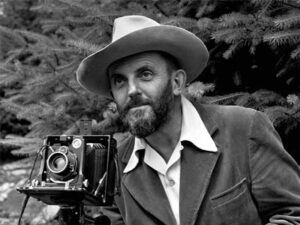 Ansel Adams
Ansel Adams
Ansel Adams (1902-1984)
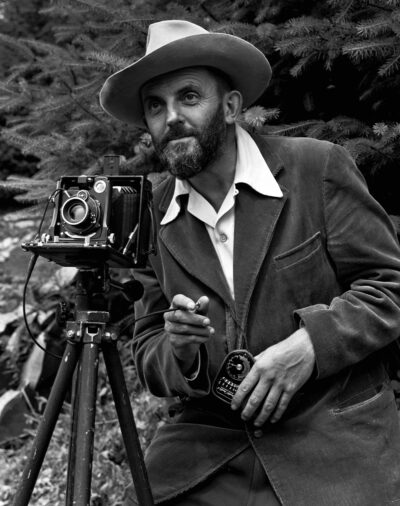 I believe the approach of the artist and the approach of the environmentalist are fairly close in that both are, to a rather impressive degree, concerned with the ‘affirmation of life.’ . . . Response to natural beauty is one of the foundations of the environmental movement.
I believe the approach of the artist and the approach of the environmentalist are fairly close in that both are, to a rather impressive degree, concerned with the ‘affirmation of life.’ . . . Response to natural beauty is one of the foundations of the environmental movement.
Ansel Easton Adams was born in San Francisco, California, where he developed a passion for photography and environmentalism. Adams was transformed and transfixed by his first visit to Yosemite National Park in 1916, which led to a life-long love for photographing nature with his Kodak Box Brownie #1 camera, a gift from his parents. Vital to Adams early success as a photographer was his decision to join the Sierra Club in 1919, where he published photographs and writings and had his first photography exhibit. He was known as a photographer, lecturer, and writer, but perhaps best known for his ability as a communicator through his photography. The black and white images of national parks and the environment itself portrayed in his photography became symbols and icons of wild America. His work as an activist for numerous conservation groups including the Sierra Club and his lobbying Congressmen, cabinet officers, and American Presidents, all reinforced the need to preserve wilderness values. Adams captured people’s desire to experience the magic of the wilderness when he stated in a letter to colleagues: “Wilderness is not only a condition of nature, but a state of mind and mood and heart.” Although our wilderness areas have become fewer and far between due to urbanization, Adams’ photography inspired people’s sociological and philosophical desire to understand the beauty of nature, while also spurring future photographers to use their abilities in the cause of environmental preservation.
The plaque was created by SUTL Cohort 33.
Photo Credit: J. Michael Greany (1947).
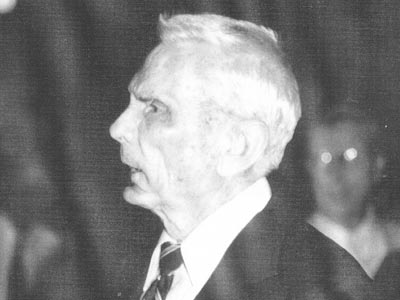 Tom Atkeson
Tom Atkeson
Thomas Atkeson (1912 –1999)
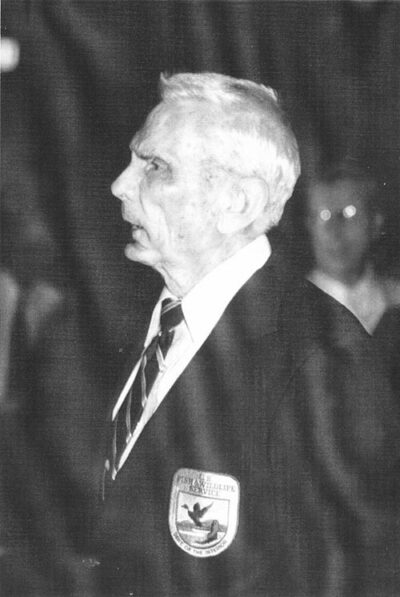 If something happened to you or me, the hawks and the owls and the eagles and swans couldn’t care less. But to me there is no more ennobling aspect of the human character than that we can care about what happens, not only to our own kind but to them. We are all, human and bird and animal, part of the same skein of life. Thomas Z. Atkeson, in The Gadsden Times, June 24, 1987
If something happened to you or me, the hawks and the owls and the eagles and swans couldn’t care less. But to me there is no more ennobling aspect of the human character than that we can care about what happens, not only to our own kind but to them. We are all, human and bird and animal, part of the same skein of life. Thomas Z. Atkeson, in The Gadsden Times, June 24, 1987
Thomas Akteson is best remembered as a biologist and manager of Wheeler National Wildlife Refuge in northern Alabama, positions he fulfilled with courage and determination for 44 years. Atkeson grew up on a farm in Alabama during the Depression, becoming an avid reader, outdoorsman, and naturalist. He earned a forestry degree from the University of Georgia and left the graduate program at Auburn University in 1939 to become a biologist at the newly created Wheeler Refuge. Wheeler Refuge was created on the shores of the Wheeler Reservoir on the recently dammed Tennessee River. His first tasks included mapping the entire refuge and overseeing reforestation efforts across the degraded refuge landscape.
During World War II, Atkeson joined the U.S. Army and, while training in Texas, was wounded by an exploding mine, permanently blinding him and resulting in the loss of his hands. Undaunted, he persevered, convinced that his life was preserved for a special purpose. After extensive rehabilitation, he was bold enough to ask to return to his former refuge position and was reinstated in 1946. Employing his keen intellect, extensive academic training, and the vivid memories of having walked the entire refuge, Atkeson served as the Refuge’s biologist for sixteen years and was promoted to refuge manager in 1962–a position he held until his retirement in 1987. His love for Wheeler Refuge was boundless and, under his leadership, Wheeler became an important stop for waterfowl and other migratory birds on the Mississippi Flyway.
Atkeson was at the forefront in demonstrating how massive impoundments created for multiple human uses could also play an important role in wildlife conservation. Atkeson pioneered management of dewatered shoreline habitats and cooperative farming to produce forage crops for wintering waterfowl. Out of his concern for ecosystem health and overall biodiversity, he advocated for prohibitions on the use of lead shot and DDT. He was especially proud of his role in the closure of the DDT plant in Triana, Alabama in 1970 after over two decades of its contamination of a creek feeding into Wheeler Reservoir. Atkeson served as a one-man public relations department for Wheeler Refuge, writing widely for newspapers, magazines, and professional publications, and received numerous local, state and national awards during his long career. While some might see his legacy as overcoming his injuries to contribute to conservation, Atkeson’s lasting legacy lay in the rich forests and other diverse habitats and wildlife populations thriving at Wheeler Refuge today.
Image Credit: Illustrations courtesy of artist Sal Catalano.
Credit: This plaque was created by SUTL Cohort 28.
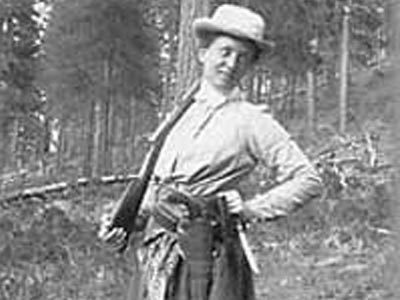 Annie Alexander
Annie Alexander
Annie Montague Alexander (1867 – 1950)
 There is a curious fascination for me in attempting something where the chances for success are but the very slightest. It is the mark of the dreamer.
There is a curious fascination for me in attempting something where the chances for success are but the very slightest. It is the mark of the dreamer.
Annie Montague Alexander was an intrepid explorer, a crack shot, photographer, world traveler, paleontologist, field biologist, natural historian, philanthropist, conservationist, and required ceaseless utility from all her activities. Born in Hawaii to a missionary family in the profitable sugarcane industry, Annie had the resources and familial encouragement to take the unconventional path of an independent woman who made vast contributions to the fields of science, natural history, and conservation. Most notable among her accomplishments was her 50 year involvement with the University of California, Berkeley where she took classes in paleontology, financed and led numerous field work expeditions, and founded and funded the Museum of Vertebrate Zoology (1908) and the Museum of Paleontology (1921). Annie never married but her spirit for adventure and industrious contribution to the natural sciences was matched and supported by her partner of 42 years, Louise Kellogg (1897 – 1967). In 1908, Annie recruited Louise as her traveling companion on a summer expedition to Alaska in order to avoid the appearance of impropriety on a trip staffed by men. Within a few short years Annie and Louise became inseparable. Together the women contributed approximately 7,000 specimens of mammals, birds, reptiles, and amphibians in addition to almost 18,000 botanical specimens to the Berkeley museums through personal collecting efforts by field expedition or through purchase. Their partnership extended beyond scientific endeavors to include ranching, asparagus farming, and philanthropy. Annie was driven to document the beauty and diversity of a landscape which, by the end of her life, was rapidly diminishing. She subscribed to the idiom that “It is better to wear out than to rust out,” and true to this sentiment she was industrious and in the field annually until her death at 82.
This plaque was created by SUTL Cohort 35.
Photo Credit: With the permission of the Museum of Paleontology, University of California, Berkeley.
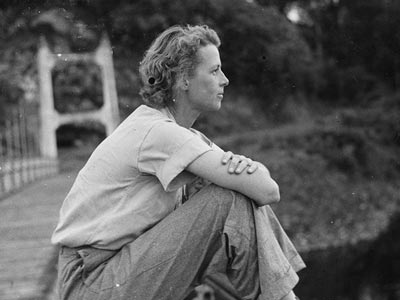 Gloria Hollister Anable
Gloria Hollister Anable
Gloria Hollister Anable (1900-1988)
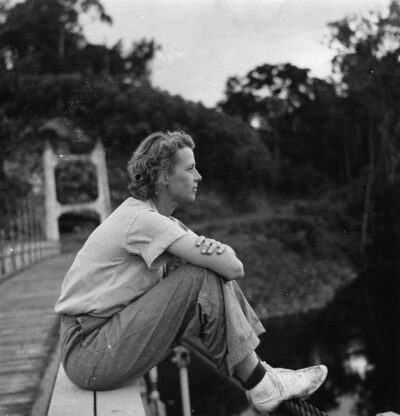 Gloria Hollister Anable, accomplished scientist, explorer, and conservationist, made substantial contributions to discovering and protecting the natural world.
Gloria Hollister Anable, accomplished scientist, explorer, and conservationist, made substantial contributions to discovering and protecting the natural world.
Born and raised in New York City, Anable’s (née Hollister) interests in animals and anatomy developed early, and were encouraged by her physician father. Anable hoped to become a physician, but her father disapproved, reflecting 1900s societal norms, and instead fostered her pursuit of natural science. Anable went on to receive a M.S. in zoology from Colombia University in 1931.
Anable’s career was multifaceted and productive, beginning with cancer research and branching into oceanographic and wildlife studies. Her groundbreaking work in the 1930s included: developing new techniques for studying bottom-dwelling fish, setting the women’s deep-sea descent record to find new marine species in the Caribbean, and discovering new plants and animals during South American expeditions.
In later years, Anable protected people and habitats. During WWII, she helped establish the first Red Cross blood bank. In the 1950’s, she led concerned citizens to protect old-growth forest along southwest New York’s Mianus River, which was under development threat. This effort led to the creation of the Nature Conservancy. Anable’s vision for the property included science education, and forward-looking resource management. Today the Mianus River Gorge Preserve is a platform for research, education, and recreation, and was the Department of Interior’s first Natural National Landmark.
Anable lived life and pursued her work with creativity, passion, and courage, despite societal challenges of the time period. Her contributions continue to benefit and inspire new generations to this day.
“Man, whether he realizes it consciously or not, has an urge to run away from what he has made for himself in order to renew his contact with the world as it was before he put his mechanical mark on it.”—Gloria Hollister Anable
This plaque was created by SUTL Cohort 34.
Photo Credit: Wildlife Conservation Society.
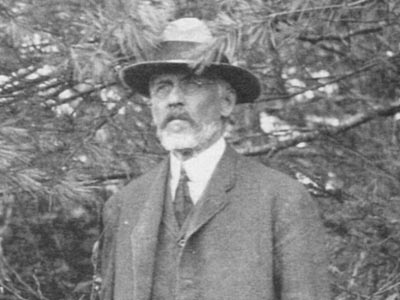 Charlie Atkins
Charlie Atkins
Charlie Atkins
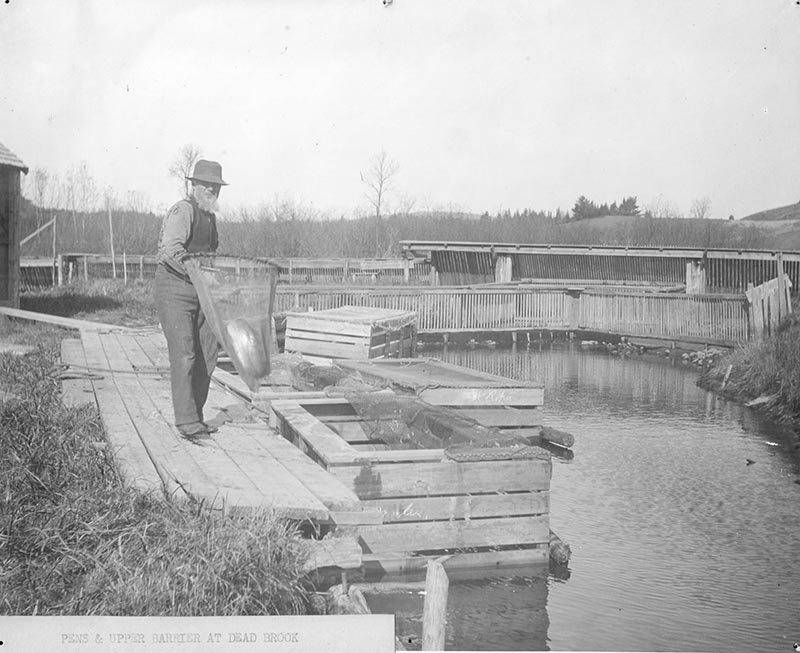
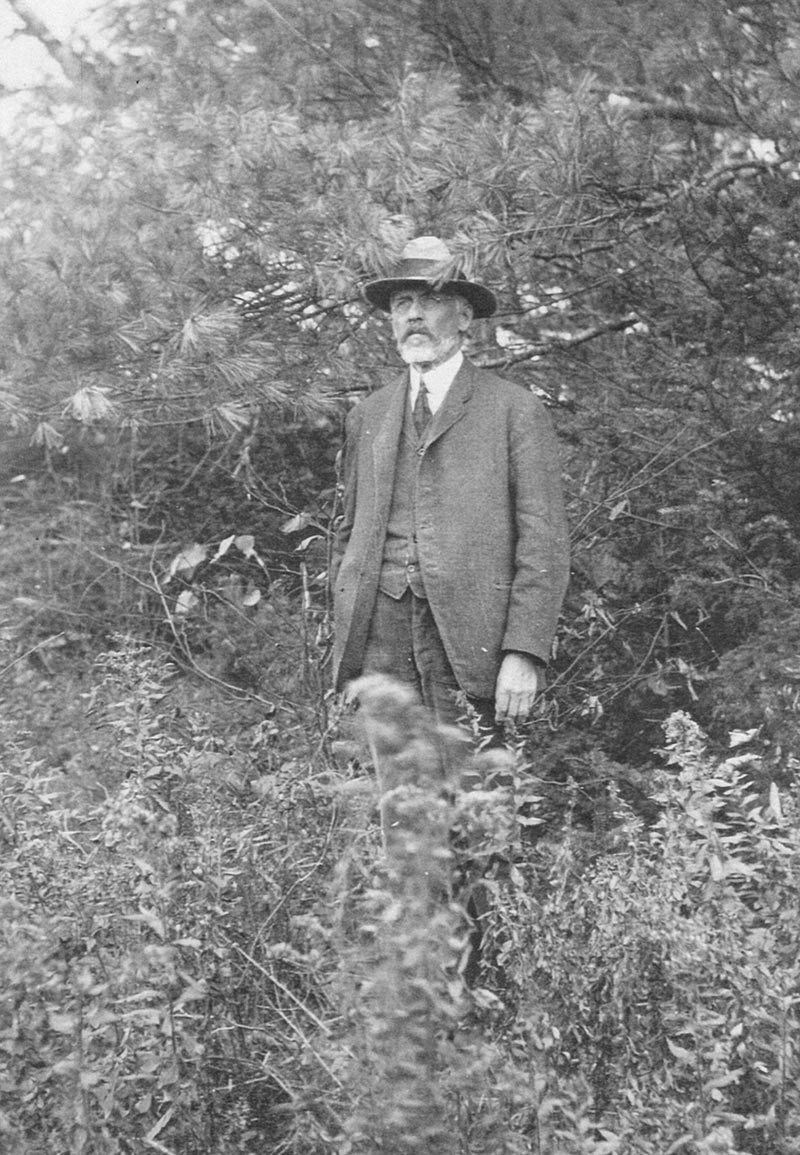
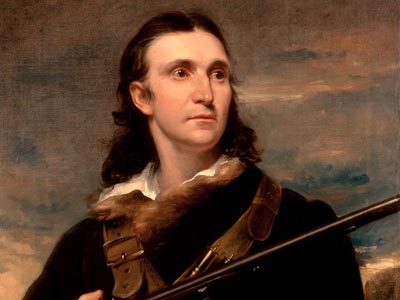 John Audubon
John Audubon
John James Audubon (1785-1851)
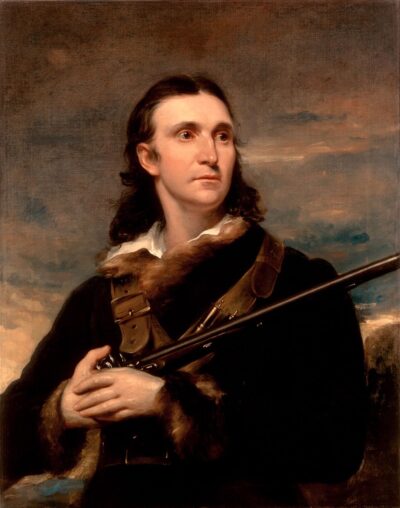 Neither this little stream, this swamp, this grand sheet of flowing water, nor these mountains will be seen in a century hence, as I see them now. The fishes will no longer bask on the surface, the eagle scarce ever alight and these millions of songsters will be drove away by man. Oh America – Look upon her, see her grandeur. Nature still nurses her, cherishes her, but a tear flows in her eye.
Neither this little stream, this swamp, this grand sheet of flowing water, nor these mountains will be seen in a century hence, as I see them now. The fishes will no longer bask on the surface, the eagle scarce ever alight and these millions of songsters will be drove away by man. Oh America – Look upon her, see her grandeur. Nature still nurses her, cherishes her, but a tear flows in her eye.
John James Audubon was born in Saint Domingue (Haiti) in 1785, the illegitimate child of a French plantation owner and his mistress. Audubon’s mother died shortly after his birth and he returned, with his father to France, where he spent the remainder of his childhood. He took a keen interest in nature from an early age, particularly in birds and drawing. In 1803, Audubon was sent to the United States where he married, started a family, and went into business. His business career flourished for many years, but Audubon suffered a series of setbacks that left him destitute by the year 1819. In 1820, Audubon committed himself to painting all of the birds of North America in life size. His artistic style was very different for the times, as he painted birds in exquisite detail and many of his works were so realistic they seemed “alive.” By 1838 Audubon accomplished his task of painting the “Birds of America,” all 435 original watercolors currently reside at the New York Historical Society. Audubon lived at a time when America was in transition from a land largely comprised of wilderness to one that was increasingly being altered by humans. He recognized this clearly in 1843 when he went West and witnessed the devastation of the vast buffalo herds and Native Americans. His paintings and writing influenced other American writers (e.g. Thoreau and Emerson) who collectively brought about the conservation movement in the second half of the 19th century.
This plaque was created by SUTL Cohort 36.
 Herma Albertson Baggley
Herma Albertson Baggley
Herma Geneva Albertson Baggley (1896-1981)
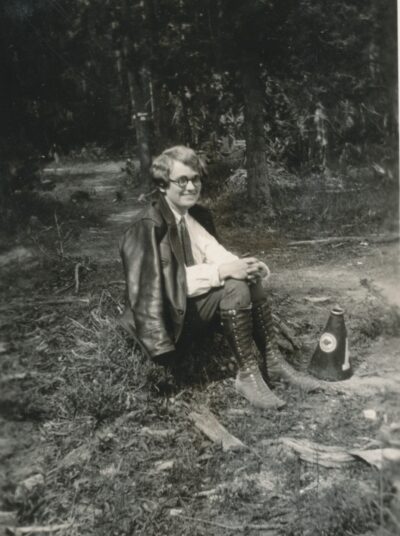 The whole surface of the earth is made beautiful by the vegetation that clothes it.
The whole surface of the earth is made beautiful by the vegetation that clothes it.
Starting as a seasonal “pillow puncher” at Old Faithful Lodge to earn room and board, Herma Albertson Baggley arrived at her dream location, Yellowstone National Park, in 1929. Growing up in Iowa and Idaho shaped her pioneering spirit, avid passion for plant life and drive to instill it in others. In 1931, she became the first permanent female park ranger for the National Park Service. Her knowledge of Yellowstone, its plants, and her interpretive skills surpassed those of her male colleagues; it was common to have hundreds attend her talks. Baggley not only taught park visitors, she also was a high school science teacher and a full-time instructor in the Botany Department at the University of Idaho, where she earned her undergraduate and graduate degrees. Though Baggley moved on from Yellowstone to raise a family, she left a legacy of information such as identifying the first rubber boa snake and park trail development. Her continued interests in the National Park Service never diminished; two decades after leaving Yellowstone, she became a founding member and the first leader of the National Park Women’s Organization. Her work with this organization improved facilities throughout the National Park Service, including employee and their family’s housing. Baggley’s most significant contribution to conservation was authoring and illustrating the Plants of Yellowstone National Park (1936), a foundational guide still in print today. Her influential and groundbreaking work continues to be an inspiration to people pursuing careers in natural resource conservation.
This plaque was created by SUTL Cohort 37.
Image: Herma Albertson Baggley courtesy of NPS, Yellowstone National Park.
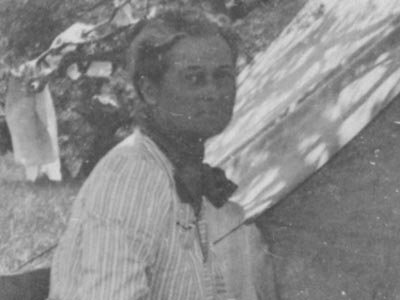 Florence Merriam Bailey
Florence Merriam Bailey
Florence Merriam Bailey (1863 – 1948)
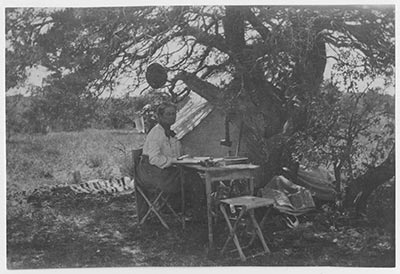 How big and simple Nature is in all her processes! How microscopic man becomes viewed in the perspective of the orderly march of the universe!
How big and simple Nature is in all her processes! How microscopic man becomes viewed in the perspective of the orderly march of the universe!
Florence Merriam Bailey was one of the first nationally recognized female ornithologists of her time and dedicated her life to educating the public about the vitality and protection of birds. As a student, she penned the first of many articles arguing against the fashionable use of bird feathers and wings as adornment. At age 26, she published her first book, Birds through an Opera-Glass, which was widely regarded as the first modern traditional bird guide. She co-organized early Audubon Society chapters and became the first female associate of the American Ornithologists Union. Her tireless role in advocating against the systematic devastation of seabirds and wading birds led in part to the congressional authorization of the Lacey Act of 1900. Bailey wrote over 100 articles for several ornithological journals and 10 books, including Birds of New Mexico–for which she was honored with the Brewster Medal. With her husband, Vernon Bailey, a U.S. Biological Survey naturalist, she traveled extensively throughout the American West to explore little-known flora and fauna. Bailey’s unwavering love of nature and remarkable powers of observation, combined with a talent for illustrative writing and a high reverence for science, inspired others to discover the diversity and value of living birds.
The plaque was created by SUTL Cohort 27.
Photo Credit: Vernon Bailey Collection, American Heritage Center, University of Wyoming
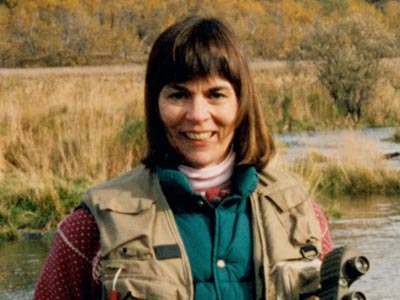 Mollie H. Beattie
Mollie H. Beattie
Mollie H. Beattie (1947-1996)
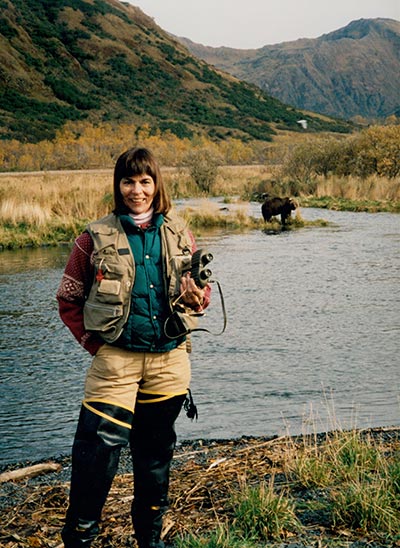 Mollie H. Beattie (1947-1996) was the first woman to become FWS Director (1993-1996). Mollie – as she was known to friend and foe alike – fiercely defended the Endangered Species Act, and the Arctic National Wildlife Refuge. She passionately advocated ecosystem approaches to conservation and reintroducing gray wolves into the American West. After her death, several Congressional antagonists joined in naming an eight-million-acre Arctic Refuge wilderness in tribute to her. Mollie lived her words noting: What a country chooses to save is what a country chooses to say about itself.
Mollie H. Beattie (1947-1996) was the first woman to become FWS Director (1993-1996). Mollie – as she was known to friend and foe alike – fiercely defended the Endangered Species Act, and the Arctic National Wildlife Refuge. She passionately advocated ecosystem approaches to conservation and reintroducing gray wolves into the American West. After her death, several Congressional antagonists joined in naming an eight-million-acre Arctic Refuge wilderness in tribute to her. Mollie lived her words noting: What a country chooses to save is what a country chooses to say about itself.
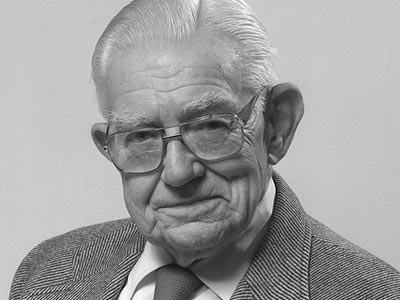 Jack Holmes Berryman
Jack Holmes Berryman
Jack Holmes Berryman, 1921 – 1999
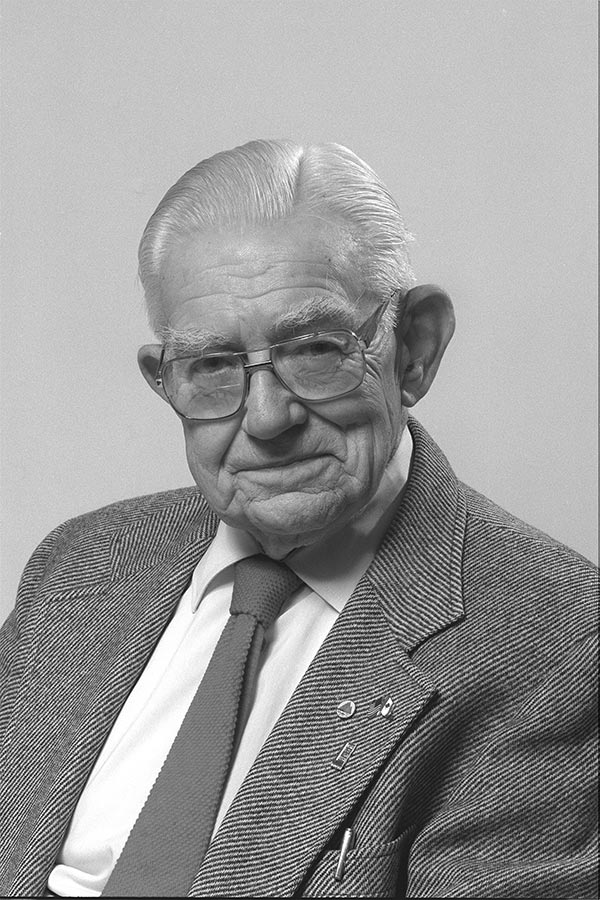 I first met Mr. Berryman – it was the longest time before I was half way comfortable calling him Jack – in 1965. He was the brand new Chief of the Division of Wildlife Services in Washington, D.C. Mr. John Gottschalk (I never ever thought of calling him John) was then the new Director of the U.S. Fish and Wildlife Service. He had been the Regional Director in Region Five in Boston and everybody there knew he was a first class gentleman.
I first met Mr. Berryman – it was the longest time before I was half way comfortable calling him Jack – in 1965. He was the brand new Chief of the Division of Wildlife Services in Washington, D.C. Mr. John Gottschalk (I never ever thought of calling him John) was then the new Director of the U.S. Fish and Wildlife Service. He had been the Regional Director in Region Five in Boston and everybody there knew he was a first class gentleman.
In 1965 I was the N.Y. State Supervisor in the Division of Wildlife Services (with nobody to supervise) at Cornell University. Mr. Berryman had called and asked me to lend a hand in a staff capacity to help revamp the Service’s animal damage control program. Although we had an understanding that I was to serve in Washington for two years and then move on, I stayed for the next 33 years.
Mr. Berryman was the most dedicated, hardest working, finest man I have ever known. Those of us who were privileged to have worked with him admired his truly exceptional personal qualities as well as his many substantial professional achievements. He set and maintained an example of high standards day after day that was emulated by his staff – and his supervisors as well. Almost every morning he visited with each staff member individually in their office for a few minutes and we talked very freely. He ferreted out points of friction or concern and built a loyal team. He had a unique talent of bringing out the best in people, and had he asked, we staff members would have walked through fire for him. We all thrived in an atmosphere of mutual, wholehearted support and the concept of teamwork, quality work, common sense, and we all did our darndest to providing the best possible service to our customers, the general public. Mr. Berryman hated the term, popular at the time, “Good enough for Government work”.
Jack and I car pooled together for many years. We parked at the Kennedy Center when the cost was $22.00 per month, and walked to the Wyatt Building on the corner of 14thand H streets. We took pride in getting to work on time regardless of the weather. He had discovered that his big Oldsmobile would climb snow covered hills better in reverse – much to the amazement of onlookers. When he drove, I became the navigator and the truth is that some of those backward rides were memorable, to say the least!
As a kid, Jack had worked in a garage and had somehow specialized in greasing automobile wheel bearings, so he had an uncanny way of recognizing the trouble with a disproportionate number of broken down cars along the side of the road – “Wheel bearing problems” he would declare – “not enough grease!”
I suspect most people who knew him were never aware of the profound effect the Second World War had on him – the horrendous memories that surely burdened him all his adult life. He rarely spoke of the years he served in the United States Marines – from 1941 to 1945, and he was twenty years old in 1941. His unit suffered over 70 percent casualties. All told there were over 4,000 killed and 14,000 wounded. He served with the Second Marine Division during the Saipan, Tinian and Okinawa operations and the occupation of Nagasaki. He was wounded twice during the Saipan/Tinian operation and was awarded the Silver Star and a Purple Heart with cluster. One night, on the point, he and another Marine in a foxhole fought an overwhelming force of elite (six feet or taller) Japanese Imperial guards, with rifles and grenades and finally in hand to hand combat with their bayonets. Both Marines survived the night, but just barely. Jack’s chest x-ray showed a spent Japanese rifle bullet and multiple fragments of a hand grenade. Later he witnessed the suicides, forced and otherwise, of civilians on the southern tip of Tinian. When we traveled together, his sleep (and mine) was frequently interrupted by nightmares – he often relived his hand to hand combat experiences. It’s easy to understand why thereafter he wanted to live his life to the fullest – he treasured and was thankful for every day. It probably explains, too, his compassion and sensitivities for all people around him in all walks of life. As one small example, he learned the names of the four female elevator operators in the Wyatt Building, and you can be sure they all though very highly of him.
My good wife Elizabeth and I have two fine offspring. Jack was their first visitor in the hospital shortly after each was born and he praised them for all their fine attributes. He frequently inquired as to their status of their tooth eruptions and their grades in school. He was present at the Court of Honor when our son became an Eagle Scout. He wrote letters of recommendations for both George and Amanda to accompany their college applications, and these carefully crafted, heartfelt letters will always be treasured. When he telephoned our home and one of our children answered, he would invariably talk with them for several minutes, even though the conversation was sometimes painfully one sided. He had tremendous personal charm, a twinkle in his eye, a delightful sense of humor, a memory that was simply astonishing – and great wisdom. He just seemed to understand without words having been spoken.
He was so proud of the Berryman Institute for Wildlife Damage Management at Utah State University and for being the recipient of the Aldo Leopold Memorial award. For me, his legacy will be lessons he taught everyone around him about professionalism and values. He espoused with pride the so-called old fashioned, traditional values – education, family, patriotism, loyalty, honesty, dependability, clear independent thinking, hard work and most of all, excellence.
It has been my view that natural resources-oriented people have unusual difficulty expressing affection, but for many of us, the years we spent working closely with Mr. Berryman will be openly cherished as THE most rewarding from a professional and personal standpoint. Those of us who worked with Jack in the service of the American public owe him a great debt of gratitude for his leadership, support and friendship. He was truly a remarkable, wonderful man.
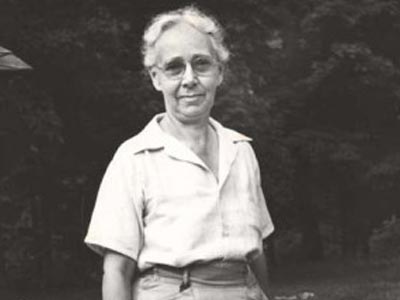 Emma Lucy Braun
Emma Lucy Braun
Emma Lucy Braun (April 19, 1889 – March 5, 1971)
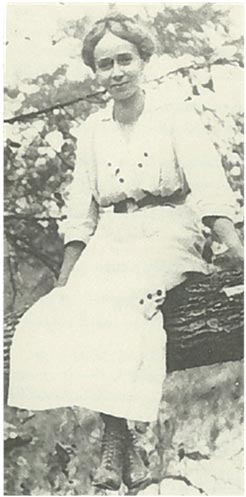 Why not save a piece of your native country, your native state, in its original condition as a monument to the original beauty and grandeur of your forests, just as you save an historical shrine?
Why not save a piece of your native country, your native state, in its original condition as a monument to the original beauty and grandeur of your forests, just as you save an historical shrine?
Emma Lucy Braun was a leader and pioneer in the field of plant ecology. Braun fought to preserve remnants of old-growth Eastern deciduous forest which were being threatened by industry. Although some of the forests were lost, her efforts resulted in over 10,000 acres of land protection in Ohio and the establishment of a land trust known as the Dr. Lucy Braun Memorial Fund, which continues to add land to her initial preservation effort to this day. She received a Ph.D. in plant ecology from the University of Cincinnati and subsequently became a professor at her alma mater. During her tenure she directed 14 graduate students, including nine women, which was unusual for a female professor in those times. Braun amassed nearly 12,000 plant specimens during her research career, a collection that now resides at the Smithsonian Institution. She authored over 180 articles in 20 different scientific journals. Her most definitive work, Deciduous Forests of Eastern North America (1950), describes the plants of Eastern deciduous forests and is still widely used as a reference. The book was based on 25 years of extensive field research conducted with her sister, Annette Frances Braun, who held a Ph.D. in entomology. The siblings covered over 65,000 miles by car and foot throughout the Appalachian region, taking detailed notes and photographs of the local flora. Braun served as the first female President of the Ecological Society of America and was the first woman inducted into the Ohio Conservation Hall of Fame.
Credit: This plaque was created by SUTL Cohort 31.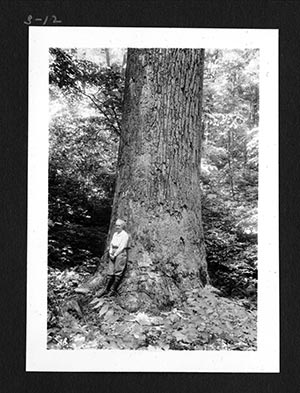
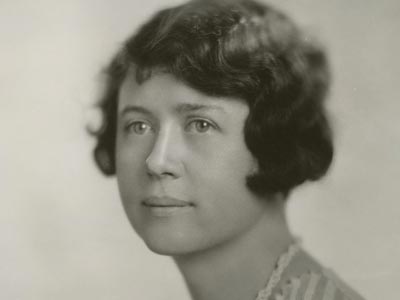 Louella Cable
Louella Cable
Louella Cable
 A Google search for “Louella Cable” produces some enthrallingly esoteric results, among the first, a publication available through Amazon: “Plankton (Fishery leaflet) Unknown Binding – 1966”; or a 1967 prototype for digital fish-measuring calipers; or, perhaps, the fish named in her honor – “Cable’s goby” – in 1933.
A Google search for “Louella Cable” produces some enthrallingly esoteric results, among the first, a publication available through Amazon: “Plankton (Fishery leaflet) Unknown Binding – 1966”; or a 1967 prototype for digital fish-measuring calipers; or, perhaps, the fish named in her honor – “Cable’s goby” – in 1933.
It’s a somehow fitting tribute to Dr. Cable who was, above all, a devoted aquatic biologist — and the first female scientist hired by the U.S. Bureau of Fisheries, the predecessor of the U.S. Fish and Wildlife Service, in 1927.
“Louella was the consummate scientist,” recalls Thomas Todd, a now retired U.S. Geological Survey fisheries expert who began his life’s work on Great Lakes whitefishes with Dr. Cable after she herself had retired from federal service in 1970. “When I was a young fisheries biologist, she was always generous to offer her ear and her expertise, which made a huge impression on me. The work we did together continued to provide fruitful research throughout my career, and we became friends for the rest of her life.”
Born and raised in South Dakota, Louella Cable attended the University of South Dakota, where she became the school’s first graduate student to study fisheries, earning a master’s degree for her work on the foods of catfish.
A superb scientific illustrator, Cable spent her first year with the government sketching fish species at the federal biological laboratory at Beaufort, North Carolina. (She would later illustrate the goby species that was subsequently named for her.) At the lab, she spent five years studying commercial fisheries with Dr. Samuel Hildebrand, a pioneer in the study of systematic ichthyology with whom she published several important articles.
Indeed, Hildebrand and Cable were at the forefront of early fish identification. According to records, in 1929, “24 local fish species had been described ‘more or less completely’ through a series of drawings illustrating their stages of development. At the time, culture methods had not been developed to enable keeping fish eggs or early larval forms in aquaria through their development – so most of these early series were drawn from individual specimens caught from the wild at various times and at different stages of development.”
In the summers of 1929 and 1930, Dr. Cable successfully reared several fish through their larval stages in the lab, a ground-breaking achievement for the study of early life history of fishes. During this period, she helped identify previously unknown larval stages of many species, including the spot, croaker, gray trout, menhaden, and pigfish.
In 1937, Dr. Cable joined the newly organized Atlantic Coast Shad Investigation Team in Charleston, South Carolina, where she worked for several years on various aspects of the ecology and early life history of the American shad.
In 1950, a decade after the U.S. Bureau of Fisheries became the Fish and Wildlife Service, she transferred to the Great Lakes Fishery Investigation Center, in Ann Arbor, Michigan, to study ciscoes of the Great Lakes. Here, in 1959, she earned a PhD from the University of Michigan, studying the scales and growth of marked lake trout in Lake Michigan.
As with so much of her work, Dr. Cable’s research in Michigan had profound and lasting impacts, according to Charles Bronte, director of the Service’s Great Lakes Fish Tagging and Recovery Lab. “As a young Service biologist tasked with working on lake trout restoration, her publication (published the year I was born) on the validity of aging these fish with scales was one of the first papers I read. The level of detail and scholarship she devoted to such a seemingly mundane topic was a model for me to strive for.”
Dr. Cable went on to write and illustrate several well-known publications on a range of ichthyology subjects throughout the remainder of her government career. And even after retiring from the Fish and Wildlife Service in 1970 at the age of 70, she remained active in her research and art, even mentoring proteges like Mr. Todd, the young biologist with whom she worked on issues pertaining to Great Lakes whitefishes. When she died in 1986, an annual scholarship fund was established in her name at her alma mater, the University of South Dakota, for promising undergraduate biology students.
-Ben Ikenson/USFWS
A more detailed profile of Dr. Cable and her work will appear in a forthcoming U.S. Fish and Wildlife Service book (as yet untitled) that documents the history of the federal agency on the occasion of its 150th anniversary in 2021.
*Photo credit: University of South Dakota Archives
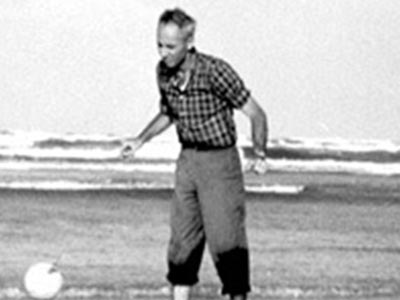 Archie Carr
Archie Carr
Dr. Archie Fairly Carr, 1909-1987
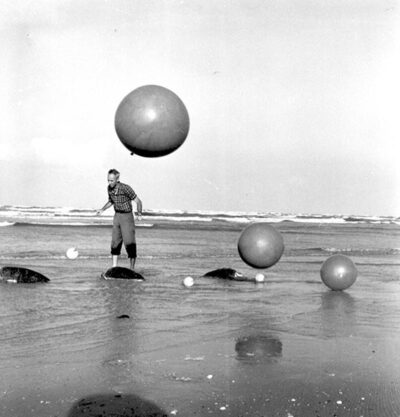 For most of the wild things on earth, the future must depend on the conscience of mankind.
For most of the wild things on earth, the future must depend on the conscience of mankind.
Archie Carr, recognized as the “father of sea turtle research,” was an extraordinary naturalist, a life-long educator, an outstanding communicator, and a prolific writer. Much of what is known about the species’ biology and life cycle is due to Carr’s work. He sought to unravel the mysteries of the sea through the turtles’ perspective and brought their plight to the world stage. Through his decades of research, teaching, and writing, Carr influenced and inspired government officials, students, and ordinary people around the world to conserve and protect sea turtles. When Carr passed away in 1987, sea turtles lost a great champion and friend, but his passion for conservation carried on to those he met, and inspired new generations of conservationists.
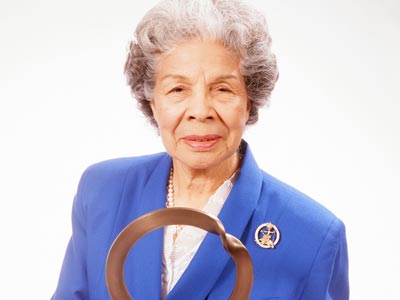 Aurora Castillo
Aurora Castillo
Aurora Castillo (1914-1998)
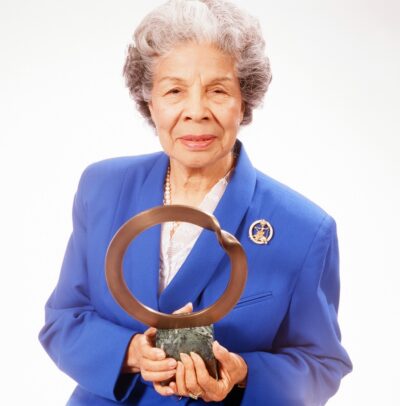 … it was not just our children we were fighting for but also the health and well-being of whole future generations. An Hispanic mother will turn into a lionness if her cub is threatened. You see, the mother is the soul of the family, but the child is the heart-beat. And that is why we keep fighting. To keep the heart of our community beating.
… it was not just our children we were fighting for but also the health and well-being of whole future generations. An Hispanic mother will turn into a lionness if her cub is threatened. You see, the mother is the soul of the family, but the child is the heart-beat. And that is why we keep fighting. To keep the heart of our community beating.
–Aurora Castillo
Community, family, motherhood, faith, equality, and environmental justice are just a few themes emblematic of Aurora Castillo’s conservation legacy. Affectionately known as “La Dona”(godmother), a title of deep respect provided by her East Los Angeles community, Castillo was a fourth-generation Mexican-American who moved to action in her seventies by co-founding the Mothers of East Los Angeles (MELA) during the late 1980s. This local grassroots organization mobilized mothers, children, fathers, and other urban community members to successfully prevent a wave of environmental injustices and hazardous projects from besieging her beloved community. MELA prevented construction of a state prison, above-ground oil pipeline, hazardous waste treatment plant, and a toxic waste incinerator. MELA inspired and collaborated with other grassroots environmental efforts around Los Angeles, fighting for a better quality of life in underserved and minority communities historically ignored, exploited, or dismissed by government and industry. At its height, MELA mobilized over 400 members and received local, national, and scholarly recognition for its work combating environmental racism and fighting for a safe and healthy environment for children in Los Angeles. MELA also garnered support among local elected officials and ultimately shattered expectations and stereotypes about the role women, underprivileged neighborhoods, and Hispanic communities can embody by speaking out against injustice, contesting environmental degradation, disavowing dangerous pollution, undermining unethical urban development, and effectively engaging in political discourse. Castillo was named the State of California’s Woman of the Year in 1989 and was awarded the prestigious Goldman Environmental Prize (known as the “Green Nobel Prize”) in 1995.
This plaque was created by SUTL Cohort 38.
Photo Credit: Goldman Environmental Prize.
 Eugenia Clark
Eugenia Clark
Eugenie Clark (1922-2015)
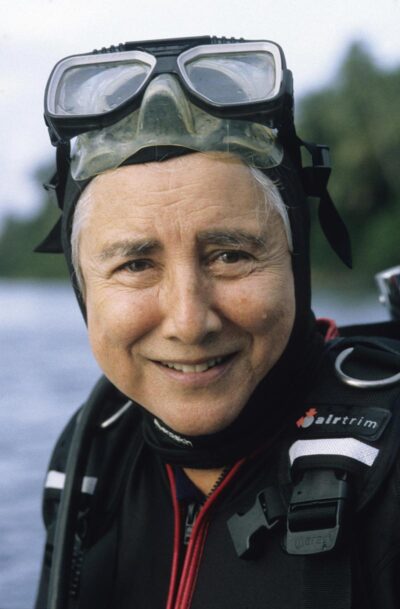 I don’t get philosophical. Love fish. Love sharks. Keep the water and their habitats as clean and protected as possible.
I don’t get philosophical. Love fish. Love sharks. Keep the water and their habitats as clean and protected as possible.
Dr. Eugenie Clark, aka “The Shark Lady,” was a world-renowned ichthyologist, deep sea explorer, educator, and communicator. Inspired by her Japanese-American heritage and childhood aquarium visits, Dr. Clark followed her passion for fish and specialized in sharks and tropical sand fishes, blazing trails for women in science. Dr. Clark’s distinguished career included over 60 years of diving (including 72 submersible dives as deep as 12,000 feet), pioneering the use of scuba gear to research animals in their natural habitat, and leading over 200 research expeditions across the world. Dr. Clark’s chronicles of her graduate research in Lady with a Spear (1953), motivated her creation of Mote Marine Lab in Sarasota, Fla. (originally Cape Haze Marine Lab in Placida, Fla.). There, Dr. Clark conducted groundbreaking behavioral experiments with large sharks, dispelling the notion that sharks were “stupid, mindless, man-eaters.” She invited and inspired the public to share her conservation research and discovery, especially schoolchildren and her own four kids. Dr. Clark took her dedication to science and teaching to the University of Maryland as a professor for 24 years, becoming a mentor and role model to a generation of marine biologists. Dr. Clark wrote three books and over 175 articles, received numerous awards, and helped establish Egypt’s first Marine National Park in the Red Sea. Those who knew Dr. Clark described her as magnificent, humble, and curious, but perhaps her greatest legacy is her uncommon ability to connect to people, change perceptions, and share her passion for ocean science, conservation, and exploration.
Credit: This plaque was created by SUTL Cohort 30.
Photo Credit: Tak Konstantinou.
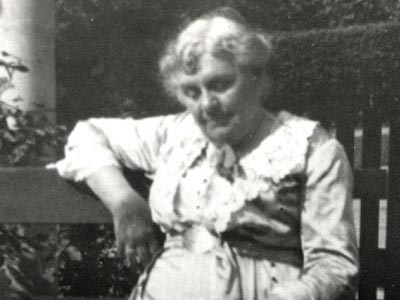 Anna Botsford Comstock
Anna Botsford Comstock
Anna Botsford Comstock (1854-1930)
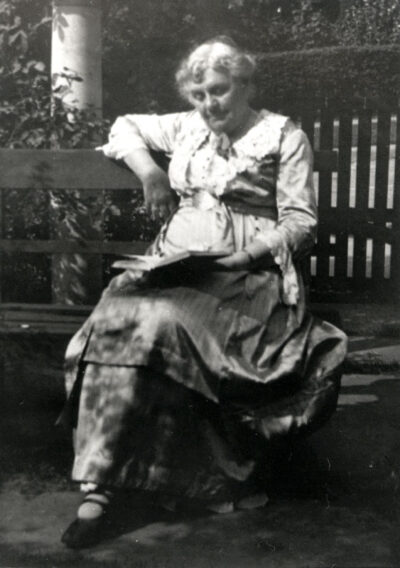 “There is not a weed or an insect or a tree so common that the child, by observing carefully, may not see things never yet recorded in scientific books….”
“There is not a weed or an insect or a tree so common that the child, by observing carefully, may not see things never yet recorded in scientific books….”
Anna Botsford Comstock, Handbook of Nature Study, 1911 (page 11)
Anna Botsford Comstock was a scientific illustrator, naturalist, conservationist, author, a leader in the nature study movement, and considered by many to be the mother of nature education. She was a pioneer in advocating that teachers should take students outdoors to learn, and worked tirelessly to promote nature education, train teachers, and produce educational materials.
While at Cornell University, Comstock met her husband and later began illustrating his entomology publications and lectures on insects. The couple subsequently founded their own publishing company, producing many books together. Appointed in 1895 to the New York State Committee for the Promotion of Agriculture, Comstock created a nature study course for public elementary schools that began as experimental, but was so successful that it was adopted for statewide use, and grew into a nationwide effort. Comstock was hired in 1897 as one of the first female professors at Cornell, but as a woman, was not offered a full professorship until 1920.
Comstock authored many books on conservation and nature education, including her most famous work, The Handbook of Nature Study. Published in 1911, it became an important resource for teachers that went through 24 editions and was translated into eight languages. Comstock has been honored by the League of Women Voters as one of America’s greatest women. By encouraging instructors and students to go outside to learn, and by teaching them about the relationship between people and nature, Comstock was a leader who left a legacy on environmental education and conservation.
This plaque was created by SUTL Cohort 30.
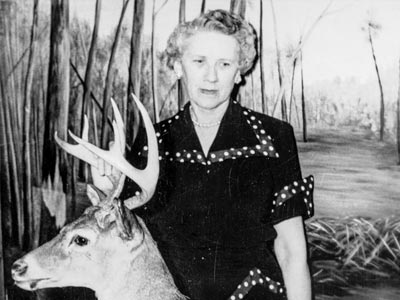 Fannye A. Cook
Fannye A. Cook
Fannye A. Cook (1889-1964)
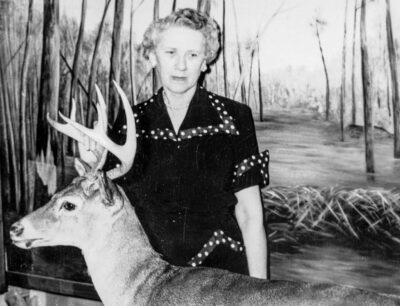 Fannye Cook was the driving force behind the creation of the Mississippi Department of Wildlife, Fisheries and Parks, and the Mississippi Museum of Natural Science. Cook dedicated her life to conservation, and advocated to make wildlife conservation a moral responsibility for everyone.
Fannye Cook was the driving force behind the creation of the Mississippi Department of Wildlife, Fisheries and Parks, and the Mississippi Museum of Natural Science. Cook dedicated her life to conservation, and advocated to make wildlife conservation a moral responsibility for everyone.
Cook traveled tirelessly throughout Mississippi in a grassroots effort to advocate for conservation causes. In 1927, she founded the Mississippi Association for the Conservation of WildLife to raise awareness of critical habitat loss and the need for species protection. Following seven determined years of advocacy and effort, the Mississippi legislature passed a bill to establish the Mississippi State Game & Fish Commission.
Cook conducted the first extensive wildlife and plant surveys in Mississippi, collecting over 28,000 specimens. The specimens were housed at the State Wildlife Museum that Cook founded and operated largely on her own. Today, the Fannye A. Cook Memorial at the Mississippi Museum of Natural Science is named in her honor.
In her later years, Cook published several books on Mississippi’s diverse wildlife, species distribution, habitat, and population abundance. She is best known for Fishes of Mississippi (1959), a textbook used by college biology students for many years. Cook continued to share her love of nature until the end of her life.
Cook was a pioneering conservationist, scientist, and teacher at a time when women were often not highly regarded or treated well within the scientific community. In November 2016, the Fannye Cook Natural Area, a 3000-acre tract of land adjacent to the Pearl River in the Jackson, Mississippi metropolitan area was dedicated to her and her life’s work.
“All citizens are responsible for the conservation of our natural resources.”
—Fannye Cook.
This plaque was created by SUTL Cohort 38.
Photo Credit: Mississippi Museum of Natural Science.
 Jacques Cousteau
Jacques Cousteau
Jacques Yves Cousteau (1910-1997)
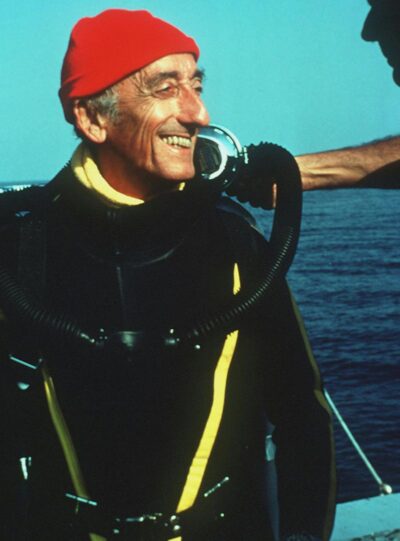 “The sea, once it casts its spell, holds one in its net of wonder forever.”
“The sea, once it casts its spell, holds one in its net of wonder forever.”
Jacques Yves Cousteau was a lifelong explorer. At a young age he took to the water and never looked back. He trained in the French Naval Academy as an aviator but a twist of fate ended his flying career and brought him back to the water where he made his mark on the world. He led a life of endless curiosity and genius. His attraction to the marine environment and the need to develop better equipment for exploring propelled him to collaborate on numerous innovations, including the ‘AquaLung’ and an underwater research vehicle (diving saucer). Cousteau’s adventures are documented in over 50 books and 120 films that brought viewers “The Undersea World of Jacques Cousteau”, which raised global awareness about the diversity of sea life. Cousteau’s passion for the marine environment was expressed through his tenacious efforts to stop the ocean dumping of nuclear waste and end commercial whaling. Cousteau’s legacy lives on through his descendants, the Cousteau Society, Cousteau Divers, and Equipe Cousteau all of whom continue his work to protect and improve the quality of life for present and future generations.
This Plaque was created by SUTL Cohort 32.
 Charles Robert Darwin
Charles Robert Darwin
Charles Robert Darwin (1809-1882)
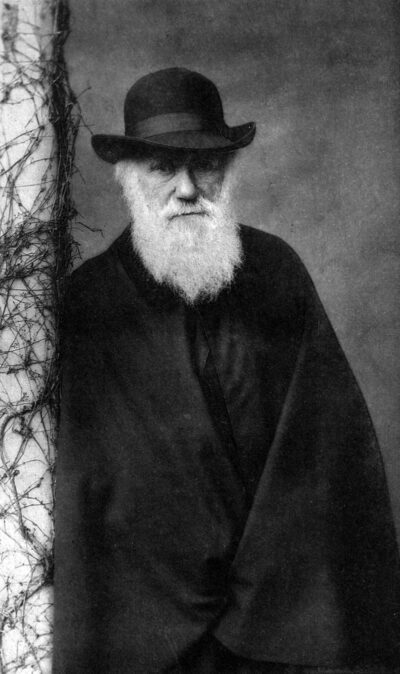 English naturalist Charles Darwin is best known for his theory of evolution by natural selection described in his 1859 book, On the Origin of Species. His seminal work is the foundation of modern evolutionary theory.
English naturalist Charles Darwin is best known for his theory of evolution by natural selection described in his 1859 book, On the Origin of Species. His seminal work is the foundation of modern evolutionary theory.
Born to a family of privilege in Shrewsbury, England, Darwin declined careers in medicine or the ministry to pursue his true passion. Upon the recommendation of his botany professor, John Stevens Henslow, Darwin was invited to serve as the naturalist on the five-year voyage of the HMS Beagle to chart the coast of South America. This voyage would forever change our understanding of the natural world. The young Darwin proved to be a keen observer, collecting specimens and taking meticulous notes on the geology, fossils, and biogeography of the odd new flora and fauna encountered. His observations of similarities and subtle variations between closely-related species, especially finches endemic to the Galápagos Islands, led to his idea of common descent with modification, better known as natural selection.
Darwin’s ideas were contrary to the 19th century’s conventional beliefs. These ideas sparked controversy as they challenged and revolutionized the paradigms of the natural world in his time. In the end, Darwin was regarded as a national hero, and was buried in Westminster Abbey following his death in 1882. Darwin’s views of evolution and adaptation have become the unifying theory of the life sciences, and they continue to drive natural resource management today in the face of contemporary conservation challenges that require comprehensive solutions.
“I am not apt to follow blindly the lead of other men I have steadily endeavoured to keep my mind free.
Credit: The plaque was created by SUTL Cohort 26.
Photo credit: Charles Darwin, Elliott and Fry, circa 1880
Photograph provided by Gene Kritsky
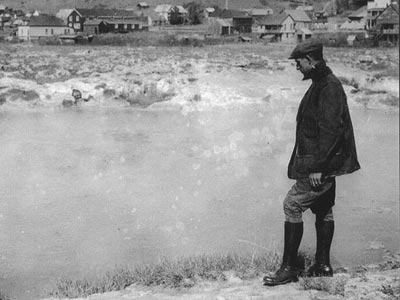 John Dingell
John Dingell
John Dingell (1894-1955)
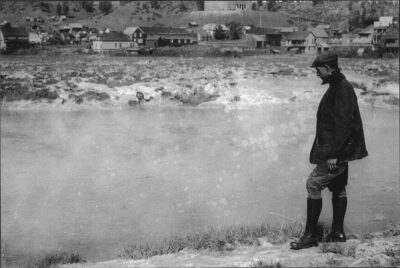 John Dingell Sr. was elected to Congress in 1932 from Michigan. As a member of the House Ways and Means Committee, he worked on many social insurance program initiatives and was one of President Franklin Delano Roosevelt’s key allies in the passage of the Social Security Act of 1935. In 1947, Dingell first proposed having anglers support conservation through fishing purchases. An avid sportsman himself, Dingell knew that hunters had supported wildlife conservation efforts since the early 1930s. The monies collected under the authority of the proposed legislation were to be returned to the states to help fund sport fisheries programs. While the bill did not pass, it ignited support with the growing number of sport fishermen around the country. In 1950, Congressman Dingell and Senator Edwin Johnson introduced a revised version and President Truman signed the Federal Aid in Sport Fish Restoration Act into law on August 9, 1950. Commonly known as the Dingell-Johnson Act, it has been a spectacular success, supporting conservation of fishery resources for more than 70years. Congressman Dingell epitomized a New Deal for American Conservation.
John Dingell Sr. was elected to Congress in 1932 from Michigan. As a member of the House Ways and Means Committee, he worked on many social insurance program initiatives and was one of President Franklin Delano Roosevelt’s key allies in the passage of the Social Security Act of 1935. In 1947, Dingell first proposed having anglers support conservation through fishing purchases. An avid sportsman himself, Dingell knew that hunters had supported wildlife conservation efforts since the early 1930s. The monies collected under the authority of the proposed legislation were to be returned to the states to help fund sport fisheries programs. While the bill did not pass, it ignited support with the growing number of sport fishermen around the country. In 1950, Congressman Dingell and Senator Edwin Johnson introduced a revised version and President Truman signed the Federal Aid in Sport Fish Restoration Act into law on August 9, 1950. Commonly known as the Dingell-Johnson Act, it has been a spectacular success, supporting conservation of fishery resources for more than 70years. Congressman Dingell epitomized a New Deal for American Conservation.
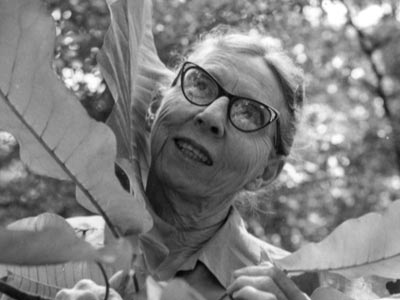 Caroline Dormon
Caroline Dormon
Caroline Dormon (1888 – 1971)
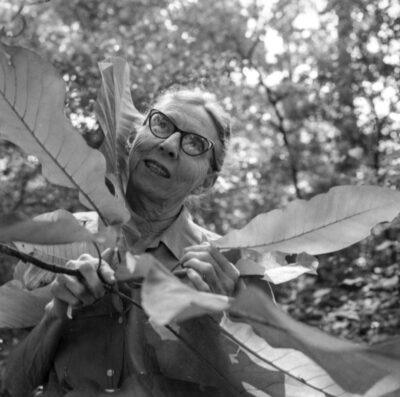 All I ask of life is to be able to stay in the woods, fooling with plants and birds.
All I ask of life is to be able to stay in the woods, fooling with plants and birds.
Celebrated as Louisiana’s first true conservationist, Caroline Dormon, or “Miss Carrie,” was an American botanist, horticulturist, ornithologist, historian, archeologist, conservationist, artist, and author. Born at Briarwood in Saline, Louisiana, Dormon began her career teaching in Louisiana’s schools. Her passion to preserve native flora led her back home to Briarwood in 1918, where she began a noteworthy career conserving and promoting the native plant communities of Louisiana.
In 1921, Dormon was the first woman ever hired by the Louisiana Department of Forestry. She wrote and illustrated numerous books on the flora and fauna of Louisiana, and was a strong advocate for preserving archaeological resources and Native American culture. She worked as a landscaping consultant for several organizations, including the Louisiana Highway Department and State Parks. Dormon’s work resulted in the establishment of the Louisiana State Arboretum, the first of its kind in the United States.
In addition to spearheading the enabling legislation, Dormon successfully persuaded the U.S. Forest Service and Congress to establish the Kisatchie National Forest in Louisiana in 1930. Her early endeavors to protect native longleaf pine forest were a key factor in the recovery of the federally endangered red-cockaded woodpecker in Louisiana.
This plaque was created by SUTL Cohort 33.
Photo Credit: NSU Watson Library, Northwestern State University, Natchitoches, LA.
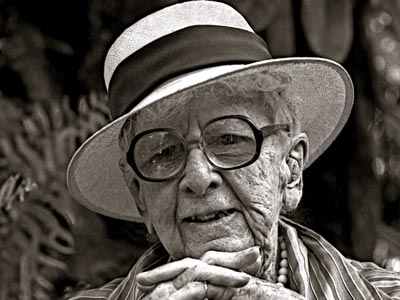 Marjory Stonemason Douglas
Marjory Stonemason Douglas
Marjory Stoneman Douglas (1890-1998)
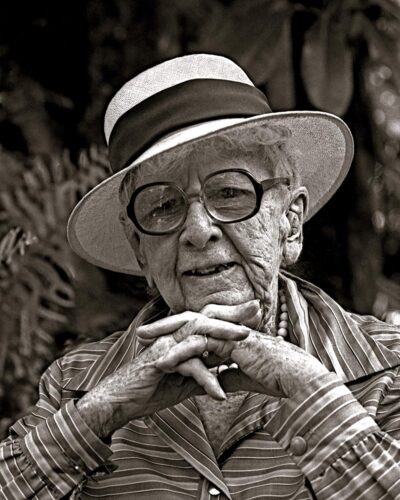 “There are no other Everglades in the world. They are, they have always been, one of the unique regions of the earth; remote, never wholly known. Nothing anywhere else is like them.”
“There are no other Everglades in the world. They are, they have always been, one of the unique regions of the earth; remote, never wholly known. Nothing anywhere else is like them.”
Called the “mother of the Everglades,” Marjory Stoneman Douglas’s outspoken defense of the tropical environment inspired the world to value this unique ecosystem. Douglas moved to Florida in 1915, quickly developing a reputation as a perceptive writer and independent thinker while working at the Miami Herald. First visiting the Everglades in the 1920s, Douglas was struck by the landscape and native wildlife. South Florida was in a period of rapid growth and development, including flood control measures that threatened to destroy the ecosystem. In 1930 she joined the Tropic Everglades Park Association, which was working to establish an Everglades National Park. Her best known literary work, The Everglades: River of Grass, was published in 1947, just before the Everglades National Park opened. The book transformed the public view of the Everglades from a useless swamp to a vibrant ecosystem essential to the region’s survival, and solidified Douglas as a leader of the south Florida conservation movement and the voice of the Everglades. At age 79, she formed Friends of the Everglades, which successfully blocked construction of a major airport that would have transformed the “river of grass” into an urban landscape. Douglas spent the rest of her long life supporting the organization’s mission “to preserve, protect, and restore the only Everglades in the world.” She has been widely recognized for her conservation achievements, receiving a Presidential Medal of Freedom in 1993. Douglas died in 1998 at the age of 108 and her ashes were scattered in her cherished Everglades National Park.
Photo Credit: Jimm Roberts
This plaque was created by SUTL Cohort 27.
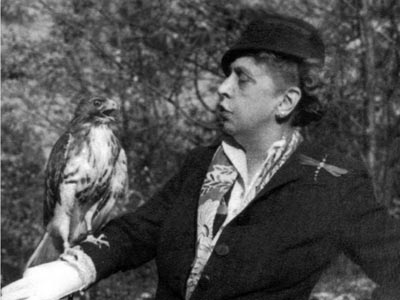 Rosalie Edge
Rosalie Edge
Rosalie Edge (1877-1962)
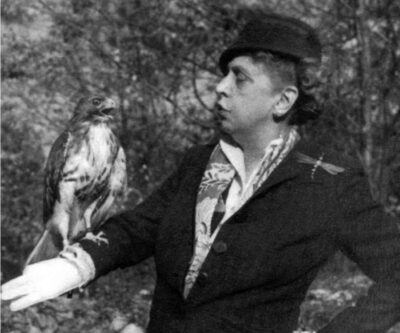 Rosalie Barrow Edge was a wealthy Manhattan socialite-turned-conservationist. In her late thirties, Edge first engaged in advocacy when fighting for women’s right to vote as a part of the New York Women’s Suffrage Party. After Congress ratified the 19th amendment, Edge spent time bird watching in Central Park and became enamored with the creatures. Ultimately, she proved to be a fierce conservationist despite having no educational background in the natural sciences. Edge pioneered the field of raptor conservation in response to the federal killing of birds of prey. She co-founded the Emergency Conservation Committee in 1929. As Chair, she wrote informational pamphlets criticizing predator control policies, which were at a odds with many of the apathetic conservationists of the time. One of her most remarkable acts was to sue the National Association of Audubon Societies for their membership list so she could directly contact members about Audubon’s practices that no longer fit their mission of protecting birds.
Rosalie Barrow Edge was a wealthy Manhattan socialite-turned-conservationist. In her late thirties, Edge first engaged in advocacy when fighting for women’s right to vote as a part of the New York Women’s Suffrage Party. After Congress ratified the 19th amendment, Edge spent time bird watching in Central Park and became enamored with the creatures. Ultimately, she proved to be a fierce conservationist despite having no educational background in the natural sciences. Edge pioneered the field of raptor conservation in response to the federal killing of birds of prey. She co-founded the Emergency Conservation Committee in 1929. As Chair, she wrote informational pamphlets criticizing predator control policies, which were at a odds with many of the apathetic conservationists of the time. One of her most remarkable acts was to sue the National Association of Audubon Societies for their membership list so she could directly contact members about Audubon’s practices that no longer fit their mission of protecting birds.
At age 57, Edge bought land in Kempton, Pennsylvania, where thousands of migratory birds were slaughtered for sport. There she founded the Hawk Mountain Sanctuary, the first wildlife preserve for birds of prey, where her legacy lives on.
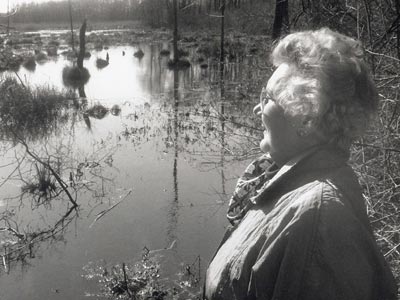 Helen Fenske
Helen Fenske
Helen Fenske (1922-2007)
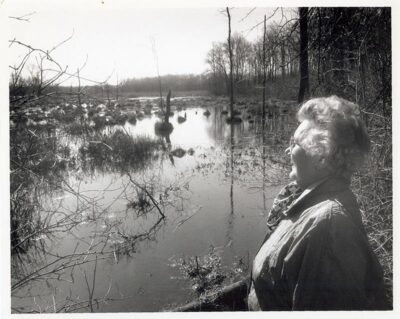 A neighborhood meeting in her New Jersey kitchen started a nine-year battle against impossible odds to save Great Swamp from becoming a 10,000 acre jetport. It also launched the influential career of a woman determined to harness the power of citizen action.
A neighborhood meeting in her New Jersey kitchen started a nine-year battle against impossible odds to save Great Swamp from becoming a 10,000 acre jetport. It also launched the influential career of a woman determined to harness the power of citizen action.
On May 29, 1964, the conservation efforts of Helen Fenske, a homemaker-turned-activist with little formal training, were recognized at the dedication ceremony of the Great Swamp National Wildlife Refuge. With Fenske as their galvanizing force, 6,100 citizens challenged the Port Authority and transformed 3,000 acres of marshland into a Federally protected wildlife refuge. Four years later, Fenske’s determination culminated in signing of the Great Swamp Wilderness Act, permanently protecting this rare area of undeveloped wetland located only 26 miles from the nation’s largest city.
“Yellin’ Helen” was a figure larger than life. Known as the grand dame of New Jersey’s environmental movement, Fenske’s influence spread well beyond Great Swamp. She fostered conservation non-profits and inspired the work of numerous environmental commissions and organizations. Her legacy grew as she worked to ensure a public voice in government policy through her work at the U.S. Environmental Protection Agency and the New Jersey Department of Environmental Protection, where she retired as acting Commissioner. She received many awards in her career, including the Department of Interior’s Conservation Service Award. For Fenske, however, nothing was more significant or more personal than protection of Great Swamp, an achievement that continues to inspire future generations with the determination to never give up.
Reach for the stars, darling. Dream the unattainable, have humor and enthusiasm. Dream the big dreams.
— Helen Fenske
Photo Credit: Courtesy of the Fenske Family.
The plaque was created by SUTL Cohort #34.
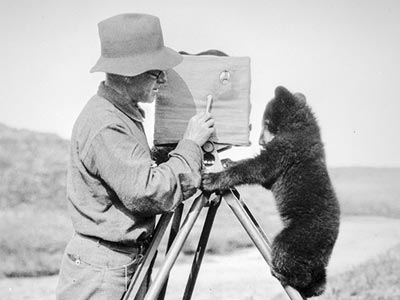 William Lovell Finley
William Lovell Finley
William Lovell Finley (1876 - 1953)
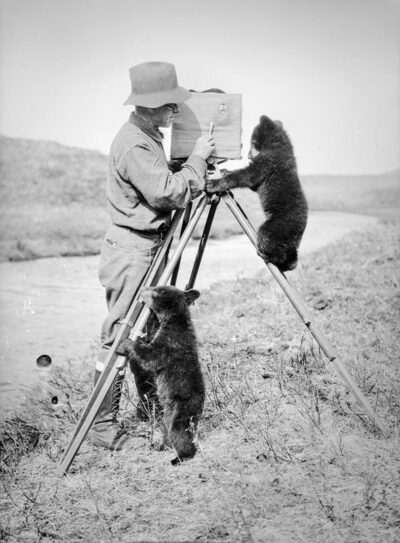 William Finley’s passion for wildlife began as a boy collecting bird eggs and skins with his childhood friend, Herman T. Bohlman. Their interest soon moved from collecting to photographing birds, going to great extremes to get their shot, from climbing high to eagle eyries, to braving ocean swells, or camping for days on offshore rock cliffs among raucous seabird colonies. Through innovative techniques, some even involving using costumes for camouflage, they captured images that compelled President Roosevelt to designate three of their photographic subjects as National Wildlife Refuges: Lower Klamath, Malheur, and Three Arch Rocks. The quality of the photographs and the comprehensive coverage of several bird species stood the test of time and some are still used today. Finley’s passion for nature inspired him to contribute to the creation of the Northwest Ornithological Association, the Oregon Audubon Society, and the Oregon Fish and Game Commission, serving the public as a Commissioner, State Game Warden, and State Biologist. Finley married Nellie Irene Barnhart in 1906, and together they travelled from the Bering Sea to the Gulf of Mexico with their children, photographing and filming wildlife. The pair published several books and countless articles for publications including Nature Magazine, National Geographic, and Field and Stream, and further sparked public interest through their lectures around the country. Finley’s articles and photographs were inspirational to noted ornithologist Roger Tory Peterson, who considered Finley’s contribution to environmental awareness as rivaling that of John Muir.
William Finley’s passion for wildlife began as a boy collecting bird eggs and skins with his childhood friend, Herman T. Bohlman. Their interest soon moved from collecting to photographing birds, going to great extremes to get their shot, from climbing high to eagle eyries, to braving ocean swells, or camping for days on offshore rock cliffs among raucous seabird colonies. Through innovative techniques, some even involving using costumes for camouflage, they captured images that compelled President Roosevelt to designate three of their photographic subjects as National Wildlife Refuges: Lower Klamath, Malheur, and Three Arch Rocks. The quality of the photographs and the comprehensive coverage of several bird species stood the test of time and some are still used today. Finley’s passion for nature inspired him to contribute to the creation of the Northwest Ornithological Association, the Oregon Audubon Society, and the Oregon Fish and Game Commission, serving the public as a Commissioner, State Game Warden, and State Biologist. Finley married Nellie Irene Barnhart in 1906, and together they travelled from the Bering Sea to the Gulf of Mexico with their children, photographing and filming wildlife. The pair published several books and countless articles for publications including Nature Magazine, National Geographic, and Field and Stream, and further sparked public interest through their lectures around the country. Finley’s articles and photographs were inspirational to noted ornithologist Roger Tory Peterson, who considered Finley’s contribution to environmental awareness as rivaling that of John Muir.
I have made business out of pleasure by lying in wait with camera and notebook. Behind the years of hunting lies an eagerness for the chase that has been fully satisfied in hunting and shooting with the camera. Outwitting has often come in outwaiting a shy subject. Some call it patience, but it is a lasting joy that has come with the quiet chances to study at bird homes and learn of the real character and individuality in these wild children of nature.
–William L. Finley, 1923.
The plaque was created by SUTL Cohort 34.
Photo Credit: Portland naturalist, William Finley, has his hands full on Unimak Island as he attempt to film “shy” bear cubs, October 1926. Oregon Historical Society and The Oregonian.
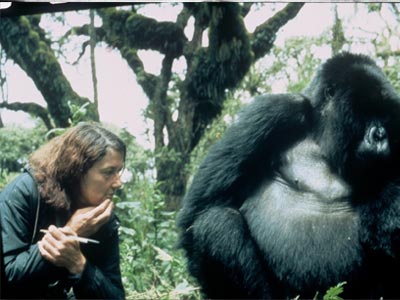 Dian Fossey
Dian Fossey
Dian Fossey (1932–1985)
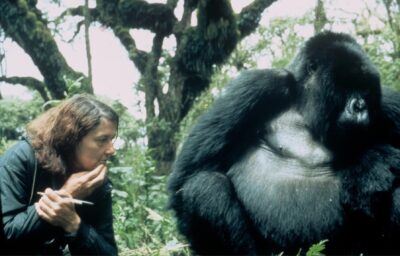 When you realize the value of all life, you dwell less on what is past and concentrate more on the preservation of the future.
When you realize the value of all life, you dwell less on what is past and concentrate more on the preservation of the future.
Dian Fossey was born in San Francisco and raised by her mother and stepfather in a highly disciplined environment. Her love of animals was fostered by a summer spent on a horse ranch, after which she enrolled in a pre-veterinary course in Biology at the University of California, Davis. Fossey struggled with science classes and transferred to San Jose State where she earned her degree in occupational therapy. She found work in a children’s hospital and worked on a farm, which reinforced her desire to work with animals. She eventually earned her PhD in Zoology from Darwin College in Cambridge in 1974. A pivotal moment in her life came when she visited Africa in 1963 and met Louis and Mary Leakey. This visit led to her first work with gorillas in the Congo in 1967. Fossey learned Swahili and the basics of gorilla tracking, continuing her work in the Virunga Mountains of Rwanda. Her ability to mimic the sounds and body language of gorillas allowed her to have unprecedented and up-close interactions with this enigmatic species. Her groundbreaking work on the behavior and social structure of gorillas laid the foundation for most of the researchers that followed. Despite protections she established and active fights against poachers, many gorillas, including her beloved Digit, were killed. Fossey founded the Digit Fund in 1977 to garner public support for gorilla conservation and, in 1983, published Gorillas in the Mist, bringing the plight of the species to the world’s attention. Her work continues today at the Karisoke Research Center in Rwanda. Fossey viewed gorillas as dignified, social creatures deserving protection from human intrusion. Her sacrifices and deep respect for the species have left a real and lasting legacy to which all can aspire.
Photo: Courtesy of The Dian Fossey Gorilla Fund International.
Credit: The plaque was created by SUTL Cohort 28.
 Billy Frank, Jr
Billy Frank, Jr
Billy Frank, Jr (1931-2014)
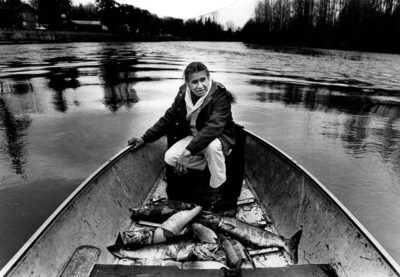 Billy Frank, Jr was a Nisqually tribal member known for his leadership during the fish wars of the 1960s and 1970s. He was the flashpoint for centuries of feuding over fishing rights along the Northwest rivers and endured unjust jail time and brutality for exercising his treaty rights. His tireless advocacy for conservation laid the groundwork for the “Boldt decision” which reaffirmed tribal rights for co-management and continued harvest of salmon resources in Washington as promulgated by the original treaties signed by the United States with the tribes. But Frank’s influence traveled far beyond fishing rights. As chair of the Northwest Indian Fisheries Commission, Frank became the champion of the movement, and successfully organized “fish-ins” to bring attention to the issues facing tribal communities. Later in life, he also worked to protect forests, restore habitat, as well as tribal treaty rights. Frank received numerous national and international awards over the years for his five decades of work including the Albert Schweitzer Prize for Humanitarianism and the highest civilian honor in the United States, the Presidential Medal of Freedom. Billy Frank Jr. was a hero to everyone concerned with the conservation of our natural resources, and his legacy will undoubtedly live on in perpetuity. Frank was a father, son, a tribal member, Marine, leader, advocate, activist, world voice, humanitarian, and conservationist, but most of all Billy Frank, Jr. was a fisherman.
Billy Frank, Jr was a Nisqually tribal member known for his leadership during the fish wars of the 1960s and 1970s. He was the flashpoint for centuries of feuding over fishing rights along the Northwest rivers and endured unjust jail time and brutality for exercising his treaty rights. His tireless advocacy for conservation laid the groundwork for the “Boldt decision” which reaffirmed tribal rights for co-management and continued harvest of salmon resources in Washington as promulgated by the original treaties signed by the United States with the tribes. But Frank’s influence traveled far beyond fishing rights. As chair of the Northwest Indian Fisheries Commission, Frank became the champion of the movement, and successfully organized “fish-ins” to bring attention to the issues facing tribal communities. Later in life, he also worked to protect forests, restore habitat, as well as tribal treaty rights. Frank received numerous national and international awards over the years for his five decades of work including the Albert Schweitzer Prize for Humanitarianism and the highest civilian honor in the United States, the Presidential Medal of Freedom. Billy Frank Jr. was a hero to everyone concerned with the conservation of our natural resources, and his legacy will undoubtedly live on in perpetuity. Frank was a father, son, a tribal member, Marine, leader, advocate, activist, world voice, humanitarian, and conservationist, but most of all Billy Frank, Jr. was a fisherman.
I don’t believe in magic. I believe in the sun and the stars, the water, the tides, the floods, the owls, the hawks flying, the river running, the wind talking. They’re measurements. They tell us how healthy things are. How healthy we are. Because we and they are the same. That’s what I believe in.—Billy Frank, Jr.
This plaque was created by SUTL Cohort 34.
Photo Credit: Billy Frank, Jr. on the Nisqually River. Courtesy of The Seattle Times.
 Jean George
Jean George
Jean Craighead George (1919-2012)
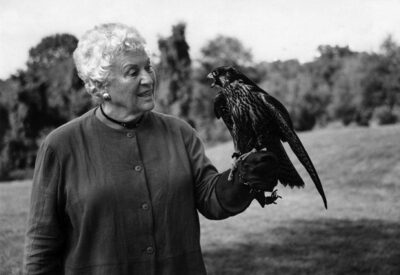 Jean Craighead George was an American author of more than 100 books penned over a span of 65 years. Written for children and young adults, her books inspired countless individuals to appreciate nature and engage in conservation. Born in Washington, D.C. and raised in a family of American naturalists, her childhood was spent roaming the banks of the Potomac River. Her deep respect and passion for the natural world, which she shared with her readers, was cultivated by her many outdoor adventures and a life-long study of nature. George’s prolific writings were inspired by her interactions with nature, including visiting the Arctic Research Laboratory in Barrow, Alaska to learn about wolf ecology. In addition, she cared for more than one hundred and seventy-three mostly-wild “pets” throughout her life; many of which became characters in her books. Her poetic prose and use of vivid details brought to life various North American ecosystems, from tropical rainforests to frozen tundra. Throughout her career, George was awarded numerous awards for her writing, including the Newbery Medal for her book Julie of the Wolves and the Newbery Honor for her book My Side of the Mountain. Her lifetime accomplishments were honored at the age of 90 when she was the recipient of the prestigious Science Books and Films Prize Lifetime Achievement Award from the American Association for the Advancement of Science. Jean Craighead George was a passionate naturalist, distinguished writer, and celebrated artist whose greatest gift was her ability to connect young readers with nature.
Jean Craighead George was an American author of more than 100 books penned over a span of 65 years. Written for children and young adults, her books inspired countless individuals to appreciate nature and engage in conservation. Born in Washington, D.C. and raised in a family of American naturalists, her childhood was spent roaming the banks of the Potomac River. Her deep respect and passion for the natural world, which she shared with her readers, was cultivated by her many outdoor adventures and a life-long study of nature. George’s prolific writings were inspired by her interactions with nature, including visiting the Arctic Research Laboratory in Barrow, Alaska to learn about wolf ecology. In addition, she cared for more than one hundred and seventy-three mostly-wild “pets” throughout her life; many of which became characters in her books. Her poetic prose and use of vivid details brought to life various North American ecosystems, from tropical rainforests to frozen tundra. Throughout her career, George was awarded numerous awards for her writing, including the Newbery Medal for her book Julie of the Wolves and the Newbery Honor for her book My Side of the Mountain. Her lifetime accomplishments were honored at the age of 90 when she was the recipient of the prestigious Science Books and Films Prize Lifetime Achievement Award from the American Association for the Advancement of Science. Jean Craighead George was a passionate naturalist, distinguished writer, and celebrated artist whose greatest gift was her ability to connect young readers with nature.
Within each person, I believe, there is an ancient twist of DNA that reacts to the beauty of the land and sky, and brings back with a rush our original love affair with nature.
Photo Credit: Susan Wood, The Raptor Project
Credit: The plaque was created by SUTL Cohort 26.
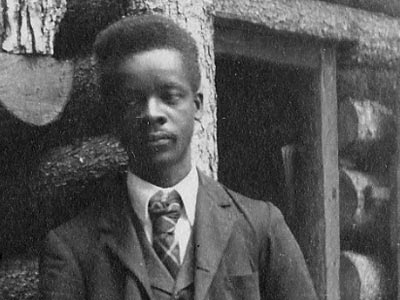 Robert Alexander Gilbert
Robert Alexander Gilbert
Robert Alexander Gilbert (1869-1942)
 Gilbert, of course, was always there in the background, the invisible man as usual, but also as usual, the driver of the machine.
Gilbert, of course, was always there in the background, the invisible man as usual, but also as usual, the driver of the machine.
–John Hanson Mitchell, in “Looking for Mr. Gilbert: The Reimagined Life of an African American.”
Robert Alexander Gilbert was a photographer and naturalist of the late nineteenth and early twentieth century, thought to be one of America’s first African-American landscape photographers. Gilbert was closely associated with New England ornithologist William Brewster, and historically described only as his servant and assistant. Due in part to this association, as well as the racial prejudice of the time, the soft-spoken Gilbert and his contributions were neglected. Gilbert was, in fact, integral to Brewster’s work documenting the birds of New England through collection of specimens and photographs. In addition, when un-signed photographic plates previously attributed to Brewster were re-examined, Gilbert was revealed as the likely photographer behind pastoral images of trees, country lanes, rivers and fencerows bathed in light.
Gilbert was a man of varied talents and accomplishments, in spite of racial and societal barriers that commonly derailed the success of people of color. In addition to his contributions in photography and natural history, he was a skillful pianist, entrepreneur, and world traveler. Gilbert ended his career as assistant to the curator of the Harvard Museum of Comparative Zoology. There, along with the museum’s other exhibits, Gilbert curated and cared for bird specimens and photographs collected in his earlier days, donated to the museum following Brewster’s death. Though Gilbert’s accomplishments were significant, history has largely overlooked him. Robert Alexander Gilbert’s previously untold story is a poignant reminder of the many unrecorded contributions of persons of color in the world of conservation.
Photo Credit: Collection of the Massachusetts Audubon Society
Note: Gilbert is on the far right in the photo
This plaque was created by SUTL Cohort 37.
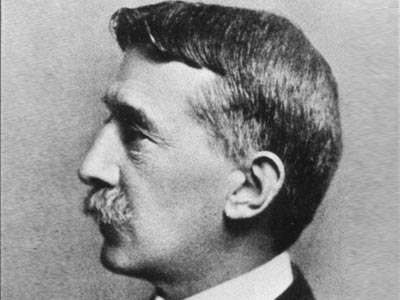 George Bird Grinell
George Bird Grinell
George Bird Grinnell (1849-1938)
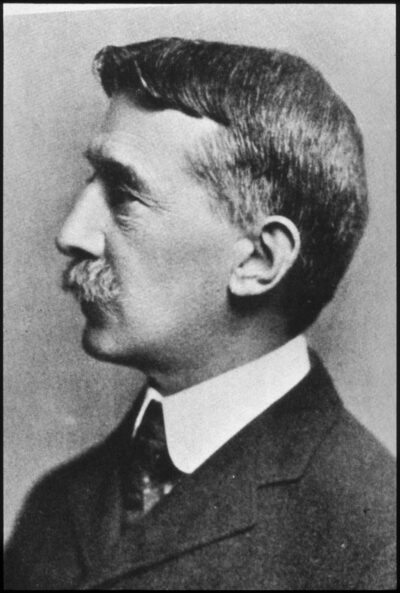 George Bird Grinnell was an influential writer, editor, and peacemaker. In his youth, he lived in Audubon Park and attended a school conducted by Lucy Bakewell Audubon. Thus began his interest in all things nature. While attending Yale, Grinnell joined several important expeditions out west, befriending many American Indian tribes. He became an advocate on their behalf in the East. Both Presidents Cleveland and Roosevelt made Grinnell a mediator between the U.S. government and American Indian tribes.
George Bird Grinnell was an influential writer, editor, and peacemaker. In his youth, he lived in Audubon Park and attended a school conducted by Lucy Bakewell Audubon. Thus began his interest in all things nature. While attending Yale, Grinnell joined several important expeditions out west, befriending many American Indian tribes. He became an advocate on their behalf in the East. Both Presidents Cleveland and Roosevelt made Grinnell a mediator between the U.S. government and American Indian tribes.
In 1880, Grinnell became senior editor and publisher of Forest and Stream magazine. Through the magazine, he campaigned intensely against market hunting and for realistic game laws, warning his fellow hunters about the dangers posed by ‘game hogs’ and lead shot. Field and Stream’s investigation into game poaching in Yellowstone National Park led Congress to pass the Yellowstone Park Protection Act of 1894, the cornerstone of the national park legislation. Grinnell founded the Audubon Society of New York, served as president of the National Parks Association, and served as trustee of the American Museum of Natural History in New York City. Grinnell lobbied for the creation of predecessor agencies to the U.S. Fish and Wildlife Service. His many writings and advocacy for establishing natural resource protection legislation serve as the world’s reminder of his lifelong dedication to conservation.
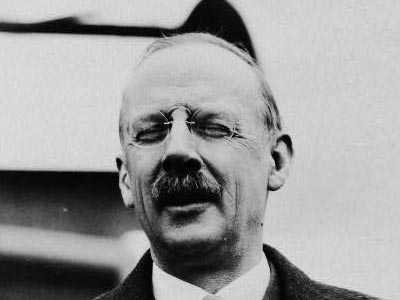 Gilbert Hovey Grosvenor
Gilbert Hovey Grosvenor
Gilbert Hovey Grosvenor (1875-1966)
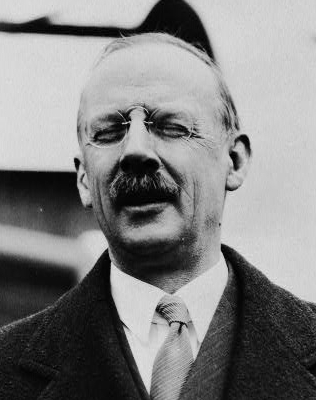 The mind must see before it can believe.
The mind must see before it can believe.
Gilbert Hovey Grosvenor revolutionized conservation while building the National Geographic Society into one of the world’s most recognizable science-based organizations. His pioneering commitment to photojournalism transformed the magazine from a technical journal into an iconic publication enjoyed by millions. During his 67 years of leadership at National Geographic Magazine, Grosvenor pioneered innovations in photography, including an 8-foot panoramic of the Canadian Rockies (1922), color underwater photography (1927), the first aerial photos of the North and South Poles, and extensive photographs of nature and wildlife. Throughout his tenure, the Society funded ambitious natural and cultural explorations on land and sea, during both peacetime and war. Explorers and scientists expressed appreciation for Grosvenor by naming discoveries of landforms, plants, and animals on five different continents after him.
Grosvenor continually promoted a conservation ethic through numerous National Geographic Society publications including a special issue of the magazine (April 1916) showcasing public lands in North America. He strategically distributed this issue to support passage of the Organic Act of 1916, which he co-authored with Stephen Mather, Horace Albright, and others to form the National Park Service. Grosvenor also contributed substantially to the formation and conservation of National Parks and Monuments across the United States. Throughout his life, Grosvenor used his passion for photography and his skill as a photojournalist to increase global awareness of nature and cultures.
Photo: Courtesy of the Library of Congress.
Credit: This plaque was created by SUTL Cohort 28.
 David Louis Hall
David Louis Hall
David Louis Hall (1938 – 2014)
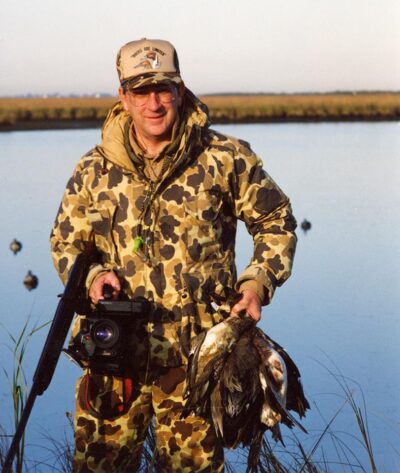 If hunting and fishing are done in the spirit of fair chase and within the confines of the laws, wildlife will be enhanced, not jeopardized. Hunters were the foundation of wildlife conservation, and without that interest there would be much less habitat left in the U.S.
If hunting and fishing are done in the spirit of fair chase and within the confines of the laws, wildlife will be enhanced, not jeopardized. Hunters were the foundation of wildlife conservation, and without that interest there would be much less habitat left in the U.S.
– Dave Hall
Dave Hall was born and raised in the Southeastern United States and under his father’s wing, he became an avid fisherman and hunter and taught himself decoy carving, bird calling, and taxidermy. At age 15, an encounter with a federal game warden set him on his course to become a wildlife enforcement officer. He received a Bachelor of Science in Forestry and a Master of Science in Zoology/Wildlife from Mississippi State University. For his thesis, Hall studied the winter foraging of mallards at Noxubee National Wildlife Refuge; one of the first wintering waterfowl ecology studies in North America. Hall began his career with the U.S. Fish and Wildlife Service in 1962 as a U.S. Deputy Game Warden at the Yazoo Refuge in Mississippi. Throughout his exceptional career, he conducted undercover investigations in seven states, which curtailed market hunting, deterred illegal wildlife trade, and saved several species from extinction including: the American alligator and Pacific walrus. Hall is perhaps best known for his ability to convince convicted poachers to become crusaders for legal hunting and sound game management. His “Poachers to Preachers” program converted game law violators into game law educators. In addition to his investigative work, Hall was an award-winning photographer and writer and a painter. He taught at universities, presented seminars to wildlife organizations, conducted hunter behavior research, served in the U.S. Air National Guard, and received an honorary Doctorate in Environmental Studies from Unity College. He retired from the U.S. Fish and Wildlife Service in 1995 after 35 years of law enforcement and public education.
This plaque was created by SUTL Cohort 31
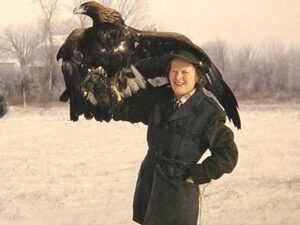 Frances Hamerstrom
Frances Hamerstrom
Frances Hamerstrom (Dec. 17, 1907 - Aug. 29, 1998)
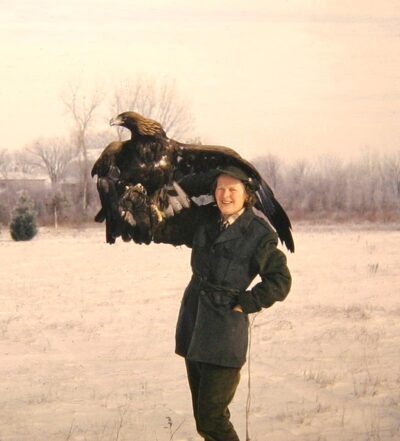 “If you are the kind of person who wakes up every morning wanting to make the world a better place, it gives a certain zest to everything you do.”
“If you are the kind of person who wakes up every morning wanting to make the world a better place, it gives a certain zest to everything you do.”
Raised in wealth and privilege in the early 1900s, when girls were not supposed to like creepy crawly creatures, Frances Hamerstrom rebelled against societal expectations. The cast of her nightly dreams were birds, mammals, and reptiles, and her youthful pastimes included filling shoeboxes with insects.
Most people did not hold Hamerstrom’s attention and, after a rocky beginning to her academic career, her path seemed unclear. Life took a turn when she found a kindred spirit in biologist Frederick Hamerstrom, whom she later married. Inspired by Dr. Aldo Leopold, Hamerstrom completed her bachelor’s degree and went on to achieve a master’s degree in wildlife biology as Leopold’s only female graduate student.
Fran and Fred Hamerstrom worked together for over half a century, focusing primarily on prairie species and birds of prey. They established grassland reserves which were credited with preventing the extirpation of the greater prairie-chicken in Wisconsin. Hamerstrom was a naturalist at heart; keeping free-flying raptors in her home provided her with intimate knowledge of their behavior and life history. These experiences emphasized her belief that field sense was more valuable than book knowledge.
Hamerstrom pursued her interests with creativity and confidence, demonstrating conservation leadership at a time when there were few women in the field. She authored over 150 scientific papers and 12 books, yet her greatest legacy lay in the influence she had on conservationists of all backgrounds, including the legions of interns she hosted in her home in Plainfield, WI over the span of 40 years.
Photo Credit Dale Paulson
This plaque was created by SUTL Cohort 27.
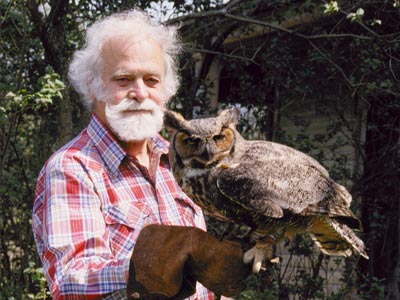 Frederick “Hammy” Hamerstrom
Frederick “Hammy” Hamerstrom
Frederick “Hammy” Hamerstrom (1909 – 1990)
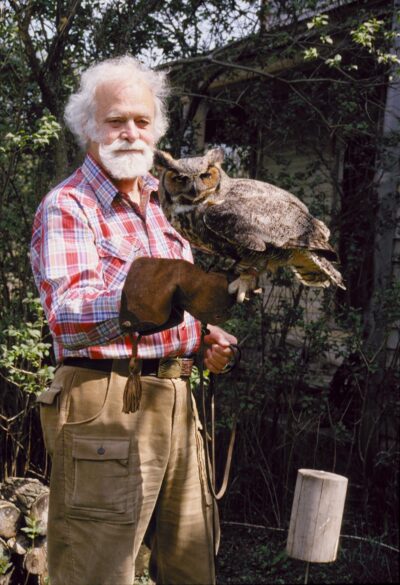 Always be kind to your listener and your reader.
Always be kind to your listener and your reader.
~ Frederick Hamerstrom
Raised in urban surroundings on the East Coast, Frederick Hamerstrom never imagined he would become a wildlife biologist. Frederick, “Hammy” to those that knew him, attended Dartmouth College where he fell in love with a young woman named Frances. The two were engaged after their third date and became inseparable. In 1931, after completing his degree in English at Harvard University, Frederick’s path changed course when he heard Dr. Aldo Leopold speak at a conference. He completed a graduate degree in Zoology under Paul Errington from Iowa State College, a PhD student under Aldo Leopold from University of Wisconsin-Madison, and worked for the Wisconsin Conservation Department/Department of Natural Resources for much of his career. In 1935, the Hamerstoms began more than 50 years of meticulous field-based research which is widely credited with saving the prairie chicken in Wisconsin. The two made a masterful team as Frances’ energy, enthusiasm and love of the limelight was well complemented by Frederick’s soft-spoken and studious nature. They developed an unconventional approach to prairie chicken habitat conservation through protection of small grassland preserves across the landscape. Frederick built partnerships with non-governmental organizations to diplomatically garner public support for the concept. Frederick also mentored dozens of aspiring biologists, always challenging his students to meaningfully articulate their research with eloquence and intention. He believed scientists must be effective communicators. The Hamerstroms received the National Wildlife Federation’s conservation award in 1971 and were inducted into the Wisconsin Conservation Hall of Fame in 1996.
Credit: This plaque was created by SUTL Cohort 36.
Photo Caption: Frederick Hamerstrom holding Porferio. Credit: lse Dietshe.
 Samuel D. Hamilton
Samuel D. Hamilton
Samuel D. Hamilton (1955-2010)
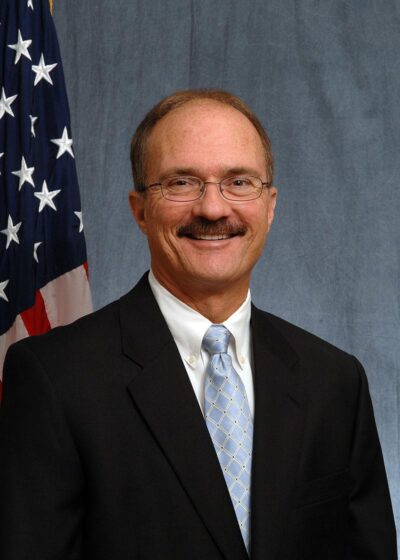 Sam Hamilton was born and raised in Starkville, Mississippi where he developed a lifelong passion for the outdoors. He caught his first fish at age 5 at the Noxubee National Wildlife Refuge in Mississippi and by age 15, he was banding waterfowl as an employee of that refuge’s Youth Conservation Corps. Hamilton worked with several U.S. Fish and Wildlife Service programs, at every level of the organization, on conservation challenges from tackling the difficult conservation issues of the Texas Hill Country, to the enormous challenges of restoring the Everglades, to national level issues at Headquarters in Washington. As Southeast Regional Director, he oversaw the many wetland and habitat restoration projects necessary after the destruction caused by Hurricane Katrina. Hamilton’s experiences gave him a deep knowledge of the Service and its mission. By the end of his 30-year career, Hamilton had risen to serve as the Director of the Service. In that role, he was visionary in pioneering how the Service would address climate change and took a lead in initiatives to attract more youth to the outdoors — the source of his own vocation. Hamilton’s sense of the mission of the Service was summed up in testimony delivered to the U.S. Senate where he noted: “It is not an exaggeration to say as wildlife goes, so goes the nation.” After Hamilton’s untimely death in 2010, the wildlife refuge that he loved so much was renamed the Sam D. Hamilton Noxubee National Wildlife Refuge.
Sam Hamilton was born and raised in Starkville, Mississippi where he developed a lifelong passion for the outdoors. He caught his first fish at age 5 at the Noxubee National Wildlife Refuge in Mississippi and by age 15, he was banding waterfowl as an employee of that refuge’s Youth Conservation Corps. Hamilton worked with several U.S. Fish and Wildlife Service programs, at every level of the organization, on conservation challenges from tackling the difficult conservation issues of the Texas Hill Country, to the enormous challenges of restoring the Everglades, to national level issues at Headquarters in Washington. As Southeast Regional Director, he oversaw the many wetland and habitat restoration projects necessary after the destruction caused by Hurricane Katrina. Hamilton’s experiences gave him a deep knowledge of the Service and its mission. By the end of his 30-year career, Hamilton had risen to serve as the Director of the Service. In that role, he was visionary in pioneering how the Service would address climate change and took a lead in initiatives to attract more youth to the outdoors — the source of his own vocation. Hamilton’s sense of the mission of the Service was summed up in testimony delivered to the U.S. Senate where he noted: “It is not an exaggeration to say as wildlife goes, so goes the nation.” After Hamilton’s untimely death in 2010, the wildlife refuge that he loved so much was renamed the Sam D. Hamilton Noxubee National Wildlife Refuge.
 Art Hawkins
Art Hawkins
Art Hawkins (1913- 2006)
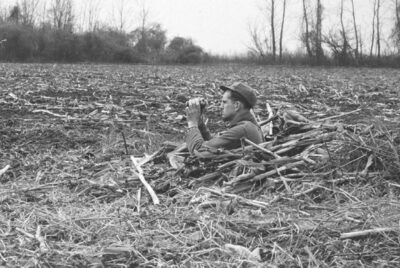 Southward in fall and northward in spring, waterfowl have followed their ancestral travel routes or ‘flyways’ since the retreating glaciers left landmarks and watery stepping stones as guideposts.
Southward in fall and northward in spring, waterfowl have followed their ancestral travel routes or ‘flyways’ since the retreating glaciers left landmarks and watery stepping stones as guideposts.
Art Hawkins was a waterfowl management pioneer in North America. Born in Batavia, New York, Hawkins enjoyed many outdoor pursuits as a boy, leading him to a career in conservation. Hawkins studied under Aldo Leopold and began his career with the U.S. Fish and Wildlife Service (USFWS) in 1946. He spent many summers with his wife, Betty, and young family living on the Canadian prairies in a cabin with no running water, studying waterfowl and developing survey methods that are still in use today. Before recording equipment was available, Hawkins conducted aerial surveys with a notepad strapped to his leg, recording what he observed. Hawkins worked throughout the Mississippi Flyway and contributed greatly to the understanding of waterfowl ecology.
It was through his dedication, leadership, and application of science that Hawkins demonstrated his greatest contribution to waterfowl conservation by making coordinated flyway management a reality. Hawkins was instrumental in the development and formation of the Flyway Councils. He served as the first USFWS representative for the Mississippi Flyway Council and recognized the need for individual flyway and species management plans, which he helped draft. In addition, he understood the need to include and account for the human dimension in waterfowl management. Hawkins retired from the Service in 1974. He was also a founding member of the Wood Duck Society and edited the text Flyways. He is remembered as a strong promoter of sportsmanship behavior and as a true gentleman dedicated to wildlife conservation.
Photo: Courtesy of Illinois Natural History Survey.
Credit: This plaque was created by SUTL Cohort 28.
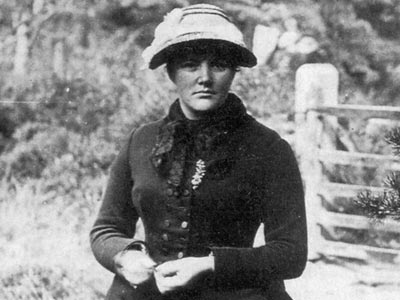 Harriet Lawrence Hemenway
Harriet Lawrence Hemenway
Harriet Lawrence Hemenway (1858-1960)
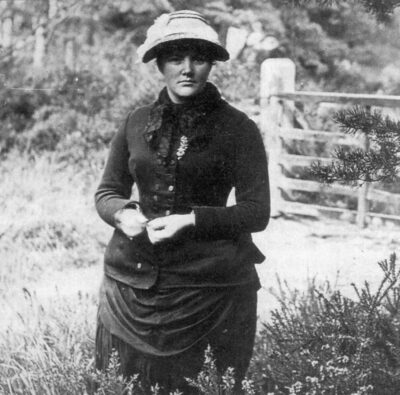 Harriet Lawrence Hemenway, a prominent member of Boston’s high society at the turn of the twentieth century, initiated one of the most influential conservation movements in American history. The mid-1800s saw a dramatic increase in the use of bird feathers, plumes, and parts for fashion, particularly women’s hats. By 1886, over 5 million birds of at least 50 species were being killed each year in the United States for their use in the fashion industry alone.
Harriet Lawrence Hemenway, a prominent member of Boston’s high society at the turn of the twentieth century, initiated one of the most influential conservation movements in American history. The mid-1800s saw a dramatic increase in the use of bird feathers, plumes, and parts for fashion, particularly women’s hats. By 1886, over 5 million birds of at least 50 species were being killed each year in the United States for their use in the fashion industry alone.
Hemenway recognized the damage being wrought in the name of women’s fashion and used her position of influence to inspire over 900 women in Boston to boycott the feather industry. She and her cousin Minna B. Hall collaborated with respected businessmen and ornithologists to found the Massachusetts Audubon Society in 1896, with Hemenway serving as the first Vice President. Audubon Societies were subsequently founded in other states and within 10 years a National Audubon Society was formed. In 1897, Hemenway and the Massachusetts Audubon Society succeeded in convincing their legislature to prohibit trade in bird feathers. Soon after, the federal Lacey Act of 1900 prohibited the interstate shipment of birds killed in violation of state laws and, by 1918, the Migratory Bird Treaty Act had effectively ended the trade, firmly rooting a wildlife conservation ethic into the American consciousness.
Hemenway lived to be 102 years old, never giving up her interest in birds and their conservation. Her actions meaningfully engaged large numbers of women in grassroots conservation, helped shift public attitudes, and led to the formation of one of the most significant conservation organizations in the country.
“In our time, as wildlands throughout the world are shrinking, as habitats and species are lost and the human population continues to expand at exponential rates, the little bird club founded by Harriet Hemenway and company back in 1896 could serve as a model for international conservation in the twenty-first century.”
– John Mitchell The Mothers of Conservation – Mass Audubon Society (1996)
This plaque was created by SUTL Cohort 36.
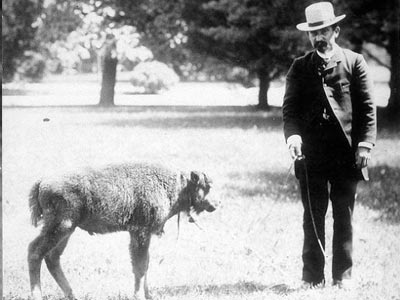 William Temple Hornaday
William Temple Hornaday
William Temple Hornaday (1854 – 1937)
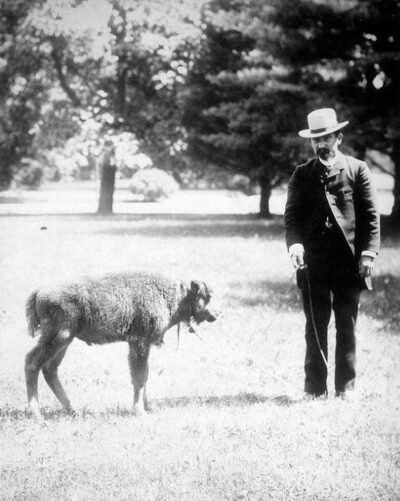 The wild things of this earth are not ours, to do with as we please. They have been given to us in trust, and we must account for them to the generations which will come after us and audit our accounts.
The wild things of this earth are not ours, to do with as we please. They have been given to us in trust, and we must account for them to the generations which will come after us and audit our accounts.
–William T. Hornaday, Our Vanishing Wild Life, Its Extermination and Preservation (1913)
A native of Iowa, William Temple Hornaday developed his passion for wildlife conservation as a young man while working as a taxidermist. In his 20s and 30s, Hornaday travelled the world collecting specimens, observing various species in their natural environment, and taking extensive notes on animal behavior. In 1882, as the Chief Taxidermist of the United States National Museum, Hornaday traveled to Montana to shoot some of the last remaining wild bison to preserve as a memorial of a species on the brink of extinction. Hornaday established the National Zoological Park in Washington, DC and the New York Zoological Park in the Bronx, where he served as director until his retirement in 1926. For nearly his entire adult life Hornaday fought vigorously for the conservation of animals on the brink of extinction. With assistance from colleagues, including Theodore Roosevelt and John F. Lacey, Hornaday ensured the continued existence of bison by establishing the Wichita National Forest and Game Preserve in Oklahoma, which later became the Wichita Mountains National Wildlife Refuge. He also advocated for treaties and laws to protect fur seals in Alaska and helped enact state limits on the sale of market meat. In a time when access to zoological parks and conservation was limited to the wealthy, Hornaday sought to connect people–especially young people–to nature through books and pamphlets, photographs, and non-scientific language. Despite his polarizing and sometimes controversial approach to conservation advocacy, Hornaday’s passionate defense of threatened and endangered species contributed to the preservation of biodiversity in North America and to the spread of wildlife conservation ethics worldwide.
Photo Credit: Smithsonian Institution
This plaque was created by SUTL Cohort 29.
 Celia Hunter
Celia Hunter
Celia Hunter (1919-2001)
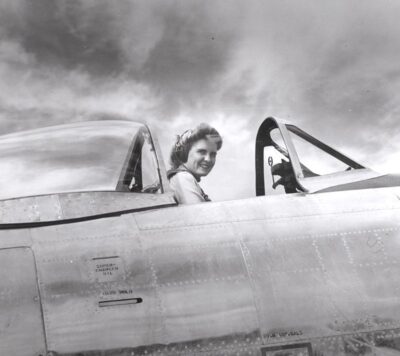 Celia Hunter was a pilot, ecotourism pioneer, and conservation advocate dedicated to preserving Alaska’s environment. Seeking adventure, Hunter and close friend Ginny Wood settled in Alaska shortly after serving as World War II Women Air Force Service Pilots. The two women and Wood’s husband were quickly captivated by the Alaskan wilderness and established Camp Denali in 1951. Operating the camp allowed them to share the Denali National Park natural areas and their conservation vision with others. To support preserving Alaska’s environment, Hunter co-founded Alaska’s first environmental organization, the Alaska Conservation Society, in 1960. The Society helped create what is now known as the Arctic National Wildlife Refuge. Under Hunter’s leadership, the Society was also influential in removing Alaskan wolf bounties, halting the Yukon River Rampart Dam project, and thwarting Project Chariot, a plan to construct an Alaskan harbor using nuclear explosions. Hunter later co-founded the Alaska Conservation Foundation, and was involved in the creation of the 1980 Alaska National Interest Lands Conservation Act, which protected over 100 million acres of Alaskan federal lands. A respected conservation leader, Hunter became the first woman to lead a national conservation association when she was elected as the Wilderness Society president in 1976. As a result of her lifelong conservation advocacy, Hunter inspired a generation dedicated to preserving Alaska’s wilderness, and once remarked, “Each one of us has a responsibility to take care of the part of the world we live in.”
Celia Hunter was a pilot, ecotourism pioneer, and conservation advocate dedicated to preserving Alaska’s environment. Seeking adventure, Hunter and close friend Ginny Wood settled in Alaska shortly after serving as World War II Women Air Force Service Pilots. The two women and Wood’s husband were quickly captivated by the Alaskan wilderness and established Camp Denali in 1951. Operating the camp allowed them to share the Denali National Park natural areas and their conservation vision with others. To support preserving Alaska’s environment, Hunter co-founded Alaska’s first environmental organization, the Alaska Conservation Society, in 1960. The Society helped create what is now known as the Arctic National Wildlife Refuge. Under Hunter’s leadership, the Society was also influential in removing Alaskan wolf bounties, halting the Yukon River Rampart Dam project, and thwarting Project Chariot, a plan to construct an Alaskan harbor using nuclear explosions. Hunter later co-founded the Alaska Conservation Foundation, and was involved in the creation of the 1980 Alaska National Interest Lands Conservation Act, which protected over 100 million acres of Alaskan federal lands. A respected conservation leader, Hunter became the first woman to lead a national conservation association when she was elected as the Wilderness Society president in 1976. As a result of her lifelong conservation advocacy, Hunter inspired a generation dedicated to preserving Alaska’s wilderness, and once remarked, “Each one of us has a responsibility to take care of the part of the world we live in.”
If we lose wild spaces, we could be a much poorer nation because the whole concept of natural areas, with intact ecosystems, is vital to life. We’ve let the daylight into our swamps. We’ve cut many of our forests. We’ve dredged and dammed. We need places of the world that are still natural.
Photo Credit: Courtesy of Ginny Wood.
Credit: The plaque was created by SUTL Cohort 26.
 Katie John
Katie John
Katie John (1915-2013)
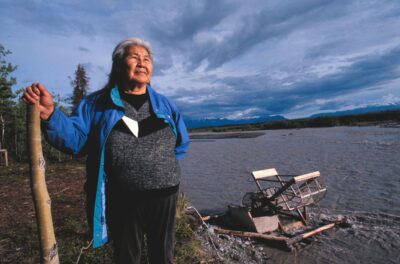 I told you how many grandchildren I have. When I’m gone, how are they going to live? . . . That’s why I’ve got to do it for all my grandchildren and great-grandchildren and my great-great-grandchildren. I don’t do this for myself. I’m too old for that now. I’m thinking about the many days ahead.
I told you how many grandchildren I have. When I’m gone, how are they going to live? . . . That’s why I’ve got to do it for all my grandchildren and great-grandchildren and my great-great-grandchildren. I don’t do this for myself. I’m too old for that now. I’m thinking about the many days ahead.
Katie John was an Ahtna Athabascan woman who fought tirelessly to protect the subsistence way of life for Alaska Native peoples. Born in 1915 at Slana, Alaska, she was raised to live off the land in the Native Village of Baltzulneta, or “Roasted Salmon Place”. As a strong advocate of the Ahtna Athabascan language, she helped create the first written alphabet in the 1970s and taught the language to her 14 children, six foster children, and numerous grandchildren and great-grandchildren. In 1984, the Alaska State Board of Fisheries denied a request to subsistence fish at the now-abandoned Baltzulneta, ending a way of life that had been practiced by the Ahtna Athabaskan people for generations. This denial resulted in decades of litigation and the Supreme Court decision, Katie John v. Norton. Ultimately, she prevailed, with the Supreme Court recognizing the right of rural Alaskans to subsistence fish and hunt at their historical grounds and ensuring protection of this right on federal lands and waters. After Governor of Alaska Tony Knowles met with John, he stated, “I understand the strength, core and values that subsistence gives to Katie John’s family and to the thousands of similar families… I know-we all know that what Katie John does is not wrong. It is right-right for her, right for the village.” Not only was John a leader in protecting subsistence rights, but she empowered others to continue their Native culture and intrinsic connection with the land.
Photo Credit: Courtesy of Alaska Dispatch News
Credit: This plaque was created by SUTL Cohort 30.
 Claudia Alta Taylor “Lady Bird” Johnson
Claudia Alta Taylor “Lady Bird” Johnson
Claudia Alta Taylor “Lady Bird” Johnson (December 22, 1912 – July 11, 2007)
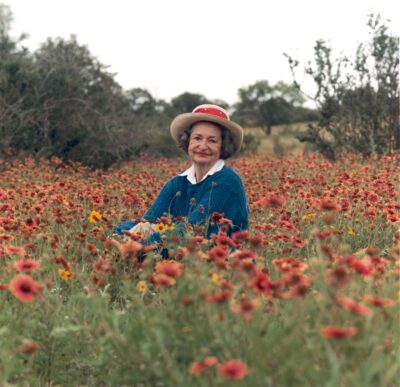 The environment is where we all meet; where all have a mutual interest; it is the one thing all of us share. It is not only a mirror of ourselves, but a focusing lens on what we can become.
The environment is where we all meet; where all have a mutual interest; it is the one thing all of us share. It is not only a mirror of ourselves, but a focusing lens on what we can become.
Claudia Alta Taylor Johnson, known by her childhood nickname “Lady Bird,” is most celebrated for her Beautification Projects and support of environmental legislation during her years as First Lady from 1963-1969. As a young child exploring the East Texas woods, Lady Bird gained a life-long appreciation for the environment. In 1934, she met and married future President Lyndon Johnson. Lady Bird was an active and integral part of her husband’s political career –effectively changing the role of the First Lady in American politics. Lady Bird’s environmental initiatives, including the Highway Beautification Act and Committee for a More Beautiful Capitol, paved the way for greater national awareness of environmental issues and encouraged more far-sighted conservation legislation. Her partnership with Secretary of the Interior Stewart Udall contributed to important conservation of National Parks and federal trust resources. After leaving Washington, Lady Bird continued her conservation efforts through the establishment of the National Wildflower Research Center. Lady Bird Johnson’s contributions to conservation have received numerous recognitions, but Stewart Udall may have summarized her legacy best: “Lady Bird Johnson did more than plant flowers in public places. She served the country superbly by planting environmental values in the minds of the nation’s leaders and citizens.”
This plaque was created by SUTL Cohort 32.
Photo Credit: LBJ Library photo by Frank Wolfe
 Rodney Jacob King
Rodney Jacob King
Rodney Jacob King (1945-2018)
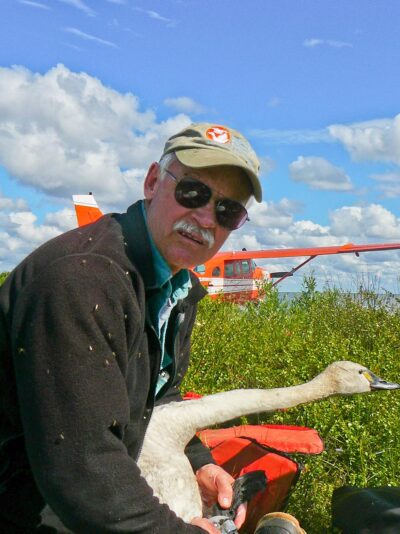 Born 7 June 1945 in Rexburg, Idaho, Rod King grew up in adjacent Sugar City, graduating from Sugar-Salem High School in 1963. He earned his Bachelor of Science Degree in Wildlife Management from Utah State University. In 1978, King began his career as a pilot/biologist with the U.S. Fish and Wildlife Service, Division of Migratory Bird Management, Anchorage, Alaska. Because King understood the diversity and importance of migratory birds in Alaska, he developed and flew aerial surveys to monitor their distribution, abundance, and population trends. In 1982, he initiated an aerial survey of flightless Canada, White fronted, and Lesser Snow geese, and Pacific Black Brant near Teshekpuk Lake. Data from this annual survey were ultimately responsible for protecting this internationally significant goose molting area. King was a pioneer in developing protocols for waterfowl banding drives. Over the next several decades, he taught the technique to other pilots and biologists. In the 1980s, an international Trumpeter Swan restoration program was initiated in several Midwestern states and Ontario. King was a conservation leader in this effort by collecting eggs from wild breeding swans in Alaska. He identified donor pairs via aerial surveys and then collected and transported partial clutches of this conservation cargo for cross-continental delivery to Minnesota, Wisconsin, Michigan, Ohio, Iowa, and Ontario effectively re-establishing the Interior Population that now number over 27,000 birds. Rod was a first rate bush pilot who was confident at the controls but not brazen in action. His surveys were flown in the vast Alaska wilderness, usually hundreds of miles from an airport, where a simple mistake could turn to unforeseen and dire consequences. He became one of the most sought after bush pilots in the USFWS. King’s scientific data sets and published accounts from aerial surveys; band returns and neck collar observations; aerial relocations of radio-marked ducks and geese; and wetland habitat monitoring form important components of waterfowl management plans for the Pacific, Central, and Mississippi Flyways. King passed away on 24 December 2018, marking the end of a distinguished career in wildlife management for which he will always be known and remembered as a conservation hero.
Born 7 June 1945 in Rexburg, Idaho, Rod King grew up in adjacent Sugar City, graduating from Sugar-Salem High School in 1963. He earned his Bachelor of Science Degree in Wildlife Management from Utah State University. In 1978, King began his career as a pilot/biologist with the U.S. Fish and Wildlife Service, Division of Migratory Bird Management, Anchorage, Alaska. Because King understood the diversity and importance of migratory birds in Alaska, he developed and flew aerial surveys to monitor their distribution, abundance, and population trends. In 1982, he initiated an aerial survey of flightless Canada, White fronted, and Lesser Snow geese, and Pacific Black Brant near Teshekpuk Lake. Data from this annual survey were ultimately responsible for protecting this internationally significant goose molting area. King was a pioneer in developing protocols for waterfowl banding drives. Over the next several decades, he taught the technique to other pilots and biologists. In the 1980s, an international Trumpeter Swan restoration program was initiated in several Midwestern states and Ontario. King was a conservation leader in this effort by collecting eggs from wild breeding swans in Alaska. He identified donor pairs via aerial surveys and then collected and transported partial clutches of this conservation cargo for cross-continental delivery to Minnesota, Wisconsin, Michigan, Ohio, Iowa, and Ontario effectively re-establishing the Interior Population that now number over 27,000 birds. Rod was a first rate bush pilot who was confident at the controls but not brazen in action. His surveys were flown in the vast Alaska wilderness, usually hundreds of miles from an airport, where a simple mistake could turn to unforeseen and dire consequences. He became one of the most sought after bush pilots in the USFWS. King’s scientific data sets and published accounts from aerial surveys; band returns and neck collar observations; aerial relocations of radio-marked ducks and geese; and wetland habitat monitoring form important components of waterfowl management plans for the Pacific, Central, and Mississippi Flyways. King passed away on 24 December 2018, marking the end of a distinguished career in wildlife management for which he will always be known and remembered as a conservation hero.
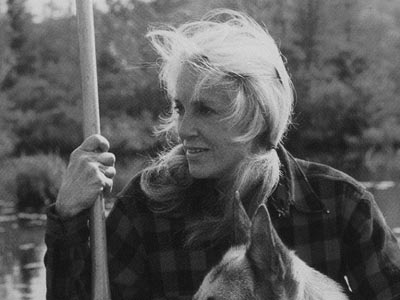 Anne LaBastille
Anne LaBastille
Anne LaBastille (November 20, 1935 - July 1, 2011)
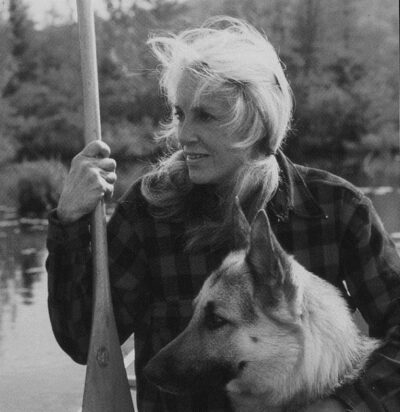 Author, ecologist, and photographer, Anne LaBastille was a pioneer of many firsts at a time in the United States when gender discrimination prevented many females from pursuing careers in the natural resources. LaBastille was the first female naturalist to guide public tours for the Audubon Society, the first female Adirondack Park Agency Commissioner, the first biologist to study the giant grebe in Guatemala, the first ecologist to document a species’ extinction from start to finish, and the founder of the first company to lead nature tours abroad. Gender discrimination forced LaBastille to publish her early scholarly articles under a male pseudonym and to self-fund her graduate studies when her scholarship was revoked. LaBastille shared her passion for ecology, conservation, and wild places through her books, articles, and photographs. She is best known for her Woodswoman series of books, in which she documented her 40-year relationship with the untouched wilderness of the Adirondack Mountains in upstate New York. On the extinction of the giant grebe, Anne wrote: “[O]ne small water bird could become a biological indicator of impending disaster, and then become a martyr to conservation… [T]his pattern of decimation is being repeated around the world, every day, every year, in every country, in every ecosystem.” LaBastille’s conservation legacy continues through her Woodswoman Scholarship Fund for females pursuing natural resource careers at Cornell University.
Author, ecologist, and photographer, Anne LaBastille was a pioneer of many firsts at a time in the United States when gender discrimination prevented many females from pursuing careers in the natural resources. LaBastille was the first female naturalist to guide public tours for the Audubon Society, the first female Adirondack Park Agency Commissioner, the first biologist to study the giant grebe in Guatemala, the first ecologist to document a species’ extinction from start to finish, and the founder of the first company to lead nature tours abroad. Gender discrimination forced LaBastille to publish her early scholarly articles under a male pseudonym and to self-fund her graduate studies when her scholarship was revoked. LaBastille shared her passion for ecology, conservation, and wild places through her books, articles, and photographs. She is best known for her Woodswoman series of books, in which she documented her 40-year relationship with the untouched wilderness of the Adirondack Mountains in upstate New York. On the extinction of the giant grebe, Anne wrote: “[O]ne small water bird could become a biological indicator of impending disaster, and then become a martyr to conservation… [T]his pattern of decimation is being repeated around the world, every day, every year, in every country, in every ecosystem.” LaBastille’s conservation legacy continues through her Woodswoman Scholarship Fund for females pursuing natural resource careers at Cornell University.
This plaque was created by SUTL Cohort 38.
 Forrest B. Lee (aka. Father Goose)
Forrest B. Lee (aka. Father Goose)
Forrest B. Lee (aka. Father Goose) 1919 - 2013
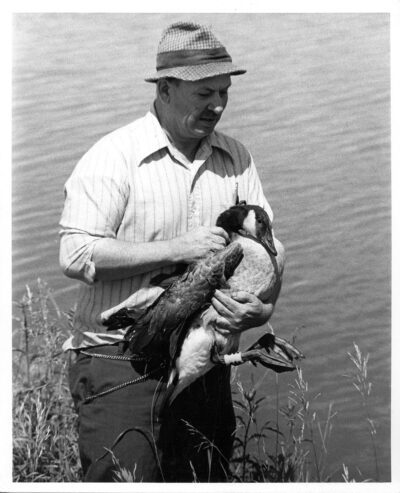 Waterfowl professionals have said that if you were to take most any giant Canada goose in existence today, you could trace its bloodlines back to an egg Forrest placed in an incubator, or a gosling Forrest held in his hand….
Waterfowl professionals have said that if you were to take most any giant Canada goose in existence today, you could trace its bloodlines back to an egg Forrest placed in an incubator, or a gosling Forrest held in his hand….
Forrest Lee was world renowned for his work with two nearly extinct species of Canada goose. His passion for geese started on the Pettibone prairie of North Dakota where he grew up watching waterfowl from his family farm. In 1942, he graduated from St. Cloud State Teachers college in Minnesota with a degree in biological science. Lee served in the Army until his honorable discharge in 1946 before returning to the University of Minnesota, receiving a Master’s degree in wildlife management and botany, which included instruction by Aldo Leopold.
In 1949 Lee joined the Minnesota Conservation Department as a biologist, eventually becoming supervisor of all game research. In 1962, Lee observed a flock of large Canada geese on Silver Lake in Rochester, Minnesota, which were later determined to be the giant Canada goose (Branta canadensis maxima), long thought to be extinct. The discovery began his drive to recover the giant Canada goose and, in 1965, Lee joined the U.S. Fish and Wildlife Service to head the Northern Prairie Wildlife Research Center’s Canada goose production and restoration program. By the end of 1981 this program had released more than 6,000 giant Canada geese in North Dakota.
In 1970, Lee joined an international effort to recover the Aleutian Canada goose, working as part of the Service’s six member Aleutian Canada Goose Recovery Team. Whether rotating eggs or leading young geese from nesting to wintering areas by plane, Lee earned the nickname ‘Father Goose’ from his colleagues. Lee officially retired from the Service in 1984, but continued to contribute to the recovery efforts after leaving the workforce.
This plaque was created by SUTL Cohort 33.
Photo Credit: Lee banding geese at Chase Lake NWR. Courtesy of The Forum of Fargo at Moorhead.
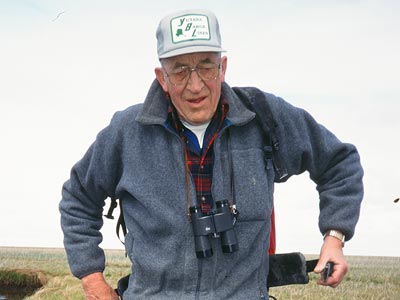 Calvin J. Lesnick
Calvin J. Lesnick
Calvin J. Lensink (1927-2009)
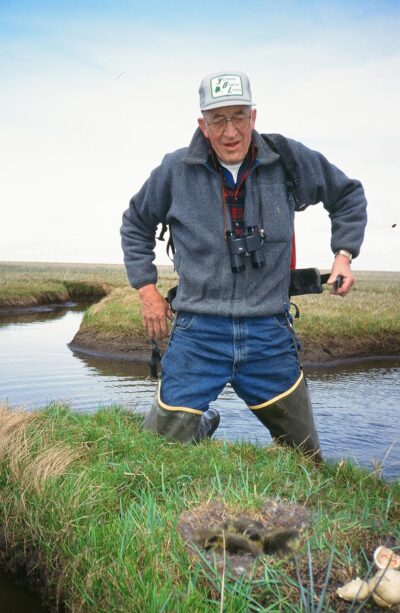 Dr. Calvin Lensink enjoyed a 30-year career with the U.S. Fish and Wildlife Service protecting the wilderness of Alaska. Growing up in the Dakotas and Minnesota inspired his love of nature and led him to obtain a Ph.D. in Wildlife Management. Lensink began his Service career studying waterfowl of the Yukon Flats where his research helped save the “flats” from a destructive dam project. In the late 1950s, he unveiled the importance of the Innoko and Upper Kuskokwim rivers for America’s waterfowl. For 10 years, Lensink served as the manager of Clarence Rhode Refuge where he pioneered waterfowl and muskox studies, which led to reintroduction of muskox to former ranges in Alaska and Russia. In 1975, Lensink assembled a team to research the birds of coastal Alaska, a project that led to the creation of the Alaska Fish and Wildlife Research Center. He co-authored the highly acclaimed publication “To Have and to Hold” that inspired expansion of the National Wildlife Refuge System in Alaska to more than 78 million acres with the passage of ANILCA in 1980. Through his leadership and wildlife knowledge, Lensink was instrumental in creating and expanding the 16 national wildlife refuges in Alaska, resulting in the preservation of millions of acres of Alaskan wilderness.
Dr. Calvin Lensink enjoyed a 30-year career with the U.S. Fish and Wildlife Service protecting the wilderness of Alaska. Growing up in the Dakotas and Minnesota inspired his love of nature and led him to obtain a Ph.D. in Wildlife Management. Lensink began his Service career studying waterfowl of the Yukon Flats where his research helped save the “flats” from a destructive dam project. In the late 1950s, he unveiled the importance of the Innoko and Upper Kuskokwim rivers for America’s waterfowl. For 10 years, Lensink served as the manager of Clarence Rhode Refuge where he pioneered waterfowl and muskox studies, which led to reintroduction of muskox to former ranges in Alaska and Russia. In 1975, Lensink assembled a team to research the birds of coastal Alaska, a project that led to the creation of the Alaska Fish and Wildlife Research Center. He co-authored the highly acclaimed publication “To Have and to Hold” that inspired expansion of the National Wildlife Refuge System in Alaska to more than 78 million acres with the passage of ANILCA in 1980. Through his leadership and wildlife knowledge, Lensink was instrumental in creating and expanding the 16 national wildlife refuges in Alaska, resulting in the preservation of millions of acres of Alaskan wilderness.
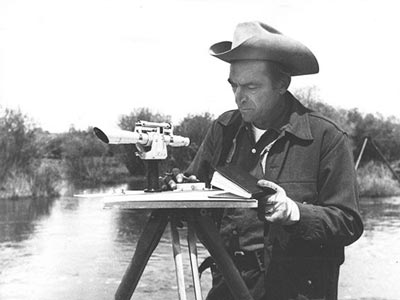 Luna Bergere Leopold
Luna Bergere Leopold
LUNA BERGERE LEOPOLD (1915-2006)
 Luna Leopold combined his training and expertise in engineering, meteorology, geology and hydrology to develop the scientific foundation for the field of fluvial geomorphology–the study of how rivers are shaped and influenced by their surrounding landscapes.
Luna Leopold combined his training and expertise in engineering, meteorology, geology and hydrology to develop the scientific foundation for the field of fluvial geomorphology–the study of how rivers are shaped and influenced by their surrounding landscapes.
From his position within the United States Geological Survey (1950 – 1972) and later as a Professor and Professor Emeritus (1972–2006) at the University of California, Berkley, Leopold was at the forefront of integrating separate fields of study of water into one: the science of hydrology. Leopold was able to connect a river’s characteristics–such as velocity, width, depth and suspended sediment load–to the formation and vegetation of the surrounding landscape. His keen observations of rivers, garnered through years of fieldwork, led to his seminal book Fluvial Processes in Geomorphology (1964). In all, Leopold authored more than 200 articles and books. These contributions form the basis of modern water resource management and environmental assessment.
Luna Bergere Leopold was the second child of famed conservation pioneer, Aldo Leopold, under whom Luna developed a passion and curiosity for the outdoors and the natural world. Leopold assembled, edited and published his father’s book of essays, A Sand County Almanac and Sketches Here and There, (1949) after his fathers’ death.
Leopold believed in balancing work with leisure. In his spare time, he hunted, fished, played guitar, painted, and wrote poetry.
The answer is not in the book or the model…it is in the river and it is up to you to read properly.
Photo courtesy of Aldo Leopold Foundation
Credit: The plaque was created by SUTL Cohort 26.
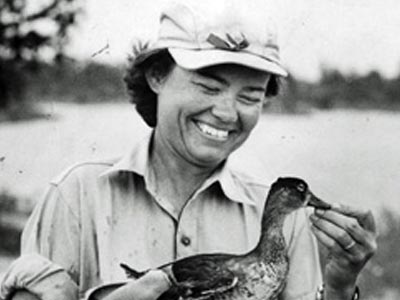 Elizabeth Beard Losey
Elizabeth Beard Losey
Elizabeth Beard Losey (1912-2004)
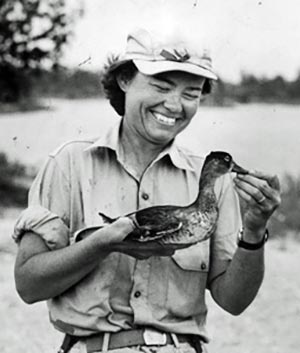 After becoming the first woman to earn a master’s degree in wildlife management and conservation from the University of Michigan, Elizabeth Beard Losey continued to carve out a path for women in conservation. In 1947, Chief of Refuges J. Clark Sayler III hired Losey as the first female field research biologist in the U.S. Fish and Wildlife Service. Her assignment was to chronicle the importance of beavers in waterfowl management at Seney National Wildlife Refuge in Michigan’s Upper Peninsula. Losey’s research earned her induction to the Wildlife Society in 1948 as its first female professional member. Although she ended her Service career for married life in the Upper Peninsula, Losey never abandoned her love for wildlife and her zeal for field studies. She developed and taught wildlife management courses at the University of Michigan, served on the Mississippi Flyway Technical Committee, and chronicled the early North American fur trade. Losey volunteered at Seney into her nineties, serving as a beloved role model for a new generation of biologists. This accomplished scientist, author, and professor will be remembered as a pioneer in gender equality in field-based scientific research and study.
After becoming the first woman to earn a master’s degree in wildlife management and conservation from the University of Michigan, Elizabeth Beard Losey continued to carve out a path for women in conservation. In 1947, Chief of Refuges J. Clark Sayler III hired Losey as the first female field research biologist in the U.S. Fish and Wildlife Service. Her assignment was to chronicle the importance of beavers in waterfowl management at Seney National Wildlife Refuge in Michigan’s Upper Peninsula. Losey’s research earned her induction to the Wildlife Society in 1948 as its first female professional member. Although she ended her Service career for married life in the Upper Peninsula, Losey never abandoned her love for wildlife and her zeal for field studies. She developed and taught wildlife management courses at the University of Michigan, served on the Mississippi Flyway Technical Committee, and chronicled the early North American fur trade. Losey volunteered at Seney into her nineties, serving as a beloved role model for a new generation of biologists. This accomplished scientist, author, and professor will be remembered as a pioneer in gender equality in field-based scientific research and study.
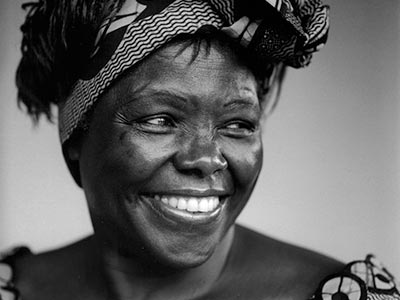 Wangari Maathai
Wangari Maathai
Wangari Maathai (1940-2011)
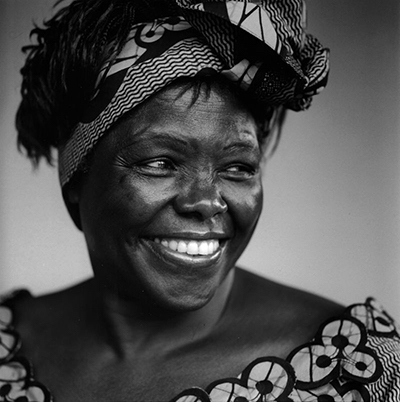 In degrading the environment, we degrade ourselves and all human kind. In the process of helping the earth to heal, we help ourselves.
In degrading the environment, we degrade ourselves and all human kind. In the process of helping the earth to heal, we help ourselves.
Wangari Maathai was born in rural Kenya, where she learned to value and respect trees and nature from her mother. At a time when most Kenyan women had no formal education, Maathai attended colleges in the United States, Germany, and Kenya, and became the first woman in East and Central Africa to receive a Ph.D.
While serving on the African Council of Women, she made the connection that many issues facing rural women, such as lack of firewood, food and clean water, was tied to the destruction of the environment. She introduced the idea of community-based tree planting, which she fostered and developed into the “Green Belt Movement”.
When politicians proposed privatizing Uhuru Park in Nairobi for development, Maathai’s environmental advocacy thrust her into the democracy movement. She was publically attacked for her non-traditional views of women and was jailed and beaten during some of her pro-democracy demonstrations. Maathai entered into politics in order to improve democracy in Kenya, serving in the parliament and as Kenya’s Assistant Minister for Environment and Natural Resources.
In 2004, Professor Maathai was internationally acknowledged for her struggle for democracy, human rights, and environmental conservation, winning the Nobel Peace Prize. Her message that people have the power to improve the environment, their economy, and bring peace resonates across cultures and remains relevant as the world addresses climate change, poverty, and regional conflicts.
(See QR code for a story told by Maathai about hummingbirds.)
Photo Courtesy of The Green Belt Movement.
This plaque was created by SUTL Cohort 29.
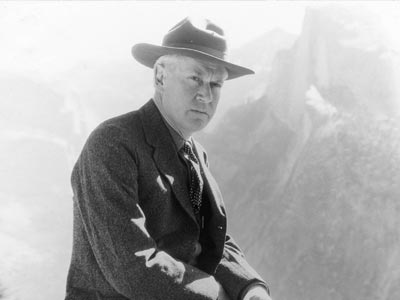 Stephen Mather
Stephen Mather
Stephen Mather (1867-1930)
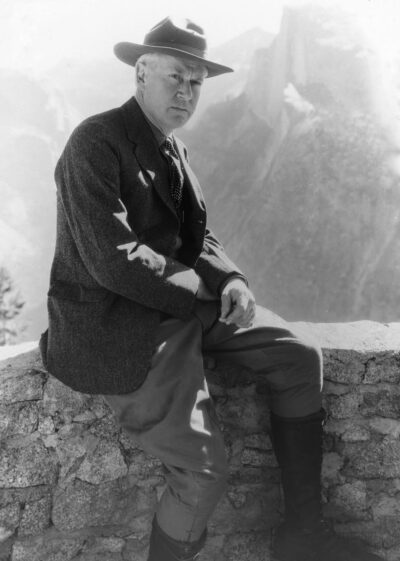 The parks do not belong to one state or to one section, the Yosemite, the Yellowstone, the Grand Canyon are national properties in which every citizen has a vested interest; they belong as much to the man of Massachusetts, of Michigan, of Florida, as they do to the people of California, of Wyoming, and of Arizona.
The parks do not belong to one state or to one section, the Yosemite, the Yellowstone, the Grand Canyon are national properties in which every citizen has a vested interest; they belong as much to the man of Massachusetts, of Michigan, of Florida, as they do to the people of California, of Wyoming, and of Arizona.
Stephen Tyng Mather was a founder and first Director of the U.S. National Park Service from 1917-1929. He forged landmark advances in the quality of the American environment for conservation and public enjoyment that included lobbying for the establishment of an agency to operate national parks. He raised funds and utilized personal funds to purchase park lands. His lobbying campaign built an awareness of the parks and was instrumental in increasing their size and number. Mather professionalized the corps of Superintendents and Rangers who managed the National Parks. As a dedicated conservationist, Mather paved the way for preservation of our nation’s scenic resources and natural areas for the public good. Today, our National Park System is a treasured and fundamental part of our national identity. The American landscape would not be the same without Mather’s pioneering vision and energy.
This Plaque was created by SUTL Cohort 32.
Photo Credit: National Park Service Historic Photograph Collection. Photographer George Stone.
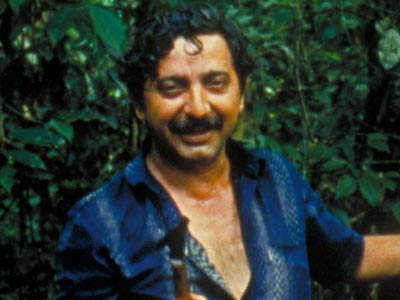 Chico Mendes
Chico Mendes
Chico Mendes (1944-1988)
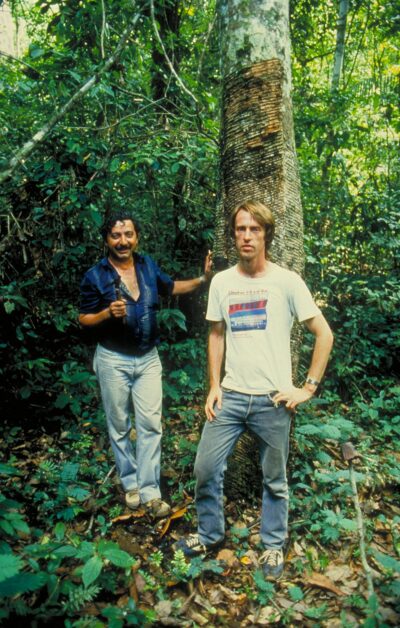 My dream is to see this entire forest conserved because we know it can guarantee the future of all the people who live in it… If a messenger from heaven came down and guaranteed that my death would help to strengthen the struggle, it could even be worth it. But experience teaches us the opposite… I want to live.
My dream is to see this entire forest conserved because we know it can guarantee the future of all the people who live in it… If a messenger from heaven came down and guaranteed that my death would help to strengthen the struggle, it could even be worth it. But experience teaches us the opposite… I want to live.
Francisco “Chico” Alves Mendes Filho, a self-educated, third generation rubber tapper (seringuero) began his unlikely career in activism and conservation as a union organizer in the rainforest of Acre, Brazil. As eviction by cattle ranchers and subsequent deforestation began threatening the livelihoods of the seringueiros and others who harvested forest products, Mendes saw that their future, and ultimately the future of the Amazon rainforest, was dependent upon responsible, sustainable development of the forest. He organized peaceful grassroots protests called “empates” to prevent forest cutting and was a tireless advocate for sustainable agricultural systems. By shepherding a nontraditional partnership between his union allies, Amazonian Indians, and international environmental organizations, he drew international attention to deforestation in the Amazon. This put him in the crosshairs of those seeking to log the forest or clear it for cattle ranching. But Mendes was a man of incorruptible character, relentlessly dedicated to his cause. Despite threats to his life, Mendes persevered in his quest. Tragically, he was assassinated by ranchers at the young age of 44. However, his work and the international outcry following his death contributed to the creation of millions of acres of working reserves in the rainforest of Brazil. Through self-education and sheer dogged determination, Chico Mendes organized peaceful resistance and forged partnerships to benefit the people, their livelihoods, and the rainforests of the Amazon.
Photo Caption: Chico Mendes (left) and Stephan Schwartzman (right) from the Environmental Defense Fund inspect a rubber tree in Xapuri, Brazil ca. 1988.
The plaque was created by SUTL Cohort 27.
Photo Credit: J.B. Forbes, St. Louis Post-Dispatch.
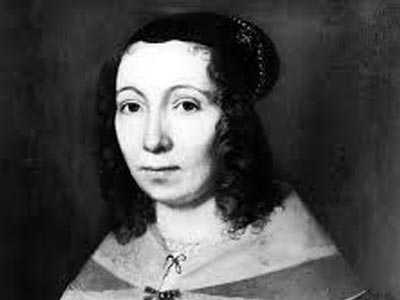 Maria Sibylla Merian
Maria Sibylla Merian
Maria Sibylla Merian (1647‐1717)
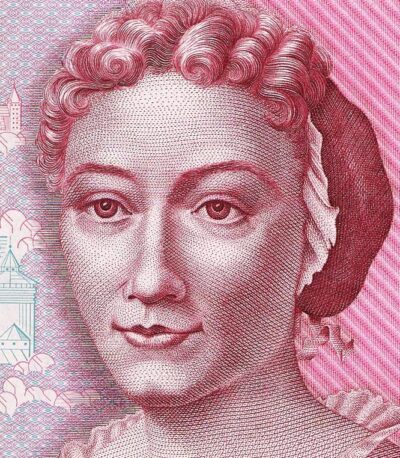
Maria Sibylla Merian was a female pioneer of science during the mid to late 1600’s. Despite no formal training, her keen sense of observation coupled with her artistic ability enabled her to convey new scientific discoveries of ecological relationships. She was one of the first to describe and illustrate the process of metamorphosis in frogs, moths, and butterflies; disputing the then‐held belief of spontaneous generation. Her innovative illustrations and simple descriptions of the ecological relationships of over 250 species of plants and animals led to groundbreaking scientific publications and were copied by other artists and scientists.
Maria’s accomplishments are quite amazing considering the political, scientific and religious beliefs of the time when non‐conformist women were often accused of witchcraft. She strategically used her artistic talents and religious doctrine to influence the elite class and to negotiate with political figures of the time. Maria independently raised her two daughters, and in 1686, moved to them to the religious Labadist Colony in Holland where she was able to continue studying metamorphosis. Her work was celebrated and earned her a grant for research in Central America. Her book Metamorphosis of Insects of Suriname, the first to describe New World plants and animals, was the highlight of her career. It was used as a template by scientists such as Linneaeus, Bartam, and Audubon among others.
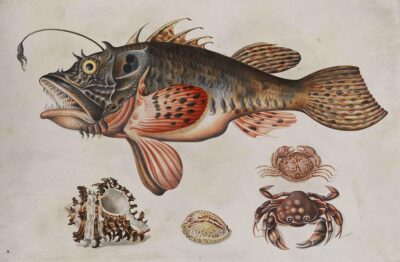 Maria is recognized as the first prominent female artist in Germany and the first female scientist in the Netherlands. Today, her artwork is highly sought after in Europe.
Maria is recognized as the first prominent female artist in Germany and the first female scientist in the Netherlands. Today, her artwork is highly sought after in Europe.
This plaque was created by SUTL Cohort 31
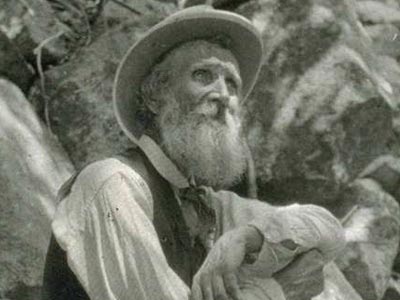 John Muir
John Muir
John Muir (1838-1914)
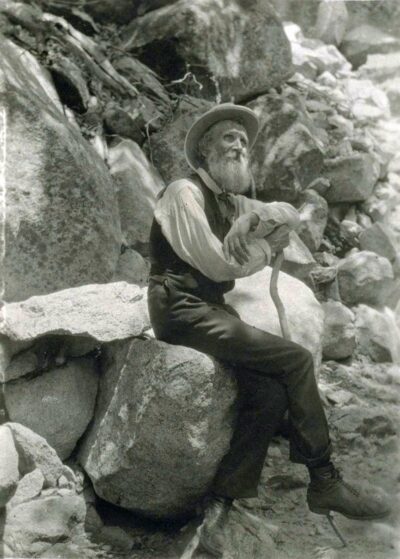 Conservation through preservation of wild lands was the philosophy championed by John Muir. His lifelong fascination with nature began in his youth in Dunbar, Scotland and grew on his family’s farm in Wisconsin. Muir never completed a college degree, but combined coursework from the University of Wisconsin-Madison with his strong religious upbringing, astute ability to observe and record nature, and extensive travels to further develop his views of the deeply spiritual connection between humans and the natural world.
Conservation through preservation of wild lands was the philosophy championed by John Muir. His lifelong fascination with nature began in his youth in Dunbar, Scotland and grew on his family’s farm in Wisconsin. Muir never completed a college degree, but combined coursework from the University of Wisconsin-Madison with his strong religious upbringing, astute ability to observe and record nature, and extensive travels to further develop his views of the deeply spiritual connection between humans and the natural world.
Unlike many of his contemporaries, Muir advocated for the protection of species and habitats solely for the sake of their long-term viability, regardless of traditional value to humans as commodities. Muir regularly corresponded with President Theodore Roosevelt and influenced efforts that expanded National Parks, Monuments, National Wildlife Refuges, and National Forests and facilitated passage of the 1906 Antiquities Act under Roosevelt. He co-founded the Sierra Club and was directly involved in the establishment of Yosemite, Seqouia, Mount Rainier, Petrified Forest, and Grand Canyon National Parks. Muir Woods National Monument, the John Muir National Historic Site, and the John Muir Wilderness are additional testaments to his lasting conservation legacy. Throughout his life, Muir penned numerous books and hundreds of articles and essays that would expose millions of readers to the wonders and significance of nature through his unique view, even long after his passing. Muir once said, “In every walk with Nature one receives far more than he seeks,” and he remains one of the most influential forces in the creation of the American Conservation Movement.
The world is big and I want to have a good look at it before it gets dark.”
Credit: The plaque was created by SUTL Cohort 26.
Picture: John Muir at Muir Woods, California, ca. 1907.
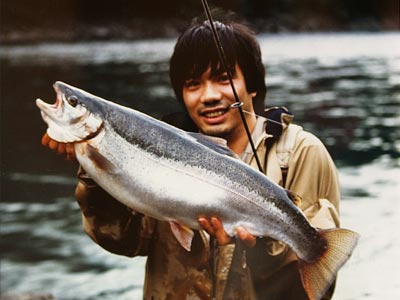 Shigeru Nakano
Shigeru Nakano
Shigeru Nakano (d. 2000)
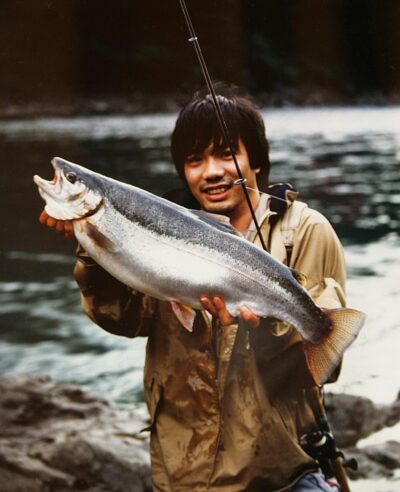 “Gambareyo na!”
“Gambareyo na!”
(You must do whatever it takes)
Shigeru Nakano’s lifelong curiosity and intimate connection with nature began in early childhood. Described by friends and colleagues as hard working and intense but kind, his passion for fishing and snorkeling in mountain streams in Japan developed into a desire to understand what was beneath the water’s surface.
Nakano began his career as a field researcher studying the feeding and social behavior of stream salmonids, and he soon became an innovative stream ecologist. Further studies involved salmonid ecology at multiple scales from local to landscape. His most significant ecological contribution was demonstrating the close linkages and interactions between terrestrial and aquatic ecosystems, based on large-scale experiments on Hokkaido island streams. His work challenged the belief that streams and riparian forests are separate habitats and showed that they function as one closely-linked ecosystem.
Nakano’s life and productive career were cut short by a tragic accident in the Sea of Cortez. At the end of his career, Nakano’s focus shifted towards an integrated understanding of humans and nature as he sought to help conserve and maintain the natural environment for future generations. His influential and collaborative work inspired ecologists worldwide to experiment, think broadly, and examine relationships at landscape scales. In the words of his close friend and colleague, “Nakano’s passion was so great, his insights into nature so clear, and his striving for excellence so inspiring, that his influence on science and our lives has transcended his passing away.”
This plaque was created by SUTL Cohort 35.
Photo Credit: Yukinori Tokuda.
 Gaylord Nelson
Gaylord Nelson
Gaylord Nelson (1916-2005)
 Let us all remember that the economy is a fully owned subsidiary of the environment and not the other way around.
Let us all remember that the economy is a fully owned subsidiary of the environment and not the other way around.
Gaylord Nelson was a distinguished leader for environmental protection and conservation throughout his political career. Growing up in the Northwoods of Wisconsin, he came to admire the natural beauty of his home state, as well as the effectiveness of political action. After service during WWII, he was elected to the Wisconsin Senate, and then to the Governor’s office. Following his stint as “The Conservation Governor”, he successfully ran for U.S. Senate in 1962 where he served with distinction until 1981. His career embodied the ideal that role of the government should be to promote the public good.
Stymied by a lack of political will in the Senate, Nelson devised a new tactic to pressure politicians towards conservation action; a grassroots, nationwide day of teach-ins. The idea evolved into the first Earth Day on April 22, 1970–an event attended by millions. The astonishing success of Earth Day catalyzed the U.S. to take action, resulting in passage of landmark legislation including the Clean Air Act, the Clean Water Act, the Endangered Species Act, and the Toxic Substances Control Act, among others. Awarded the Presidential Medal of Freedom in 1995, Gaylord Nelson introduced and saw to fruition some of the greatest environmental and conservation victories of the 20th century.
This plaque was created by SUTL Cohort 32.
Photo Credit: Benjamin Gilles. Courtesy of the Wisconsin Historical Society.
 Margaret Morse Nice
Margaret Morse Nice
Margaret Morse Nice (1883-1974)
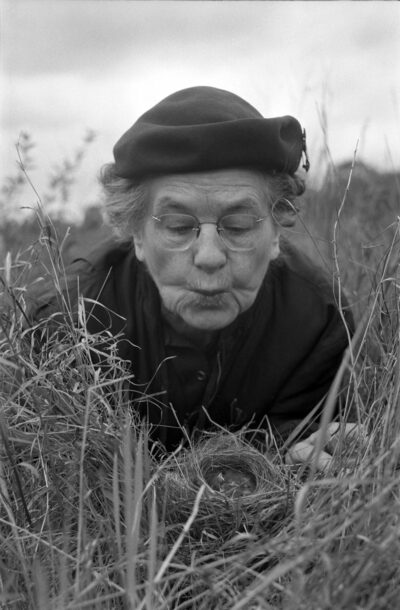 We who love nature, who see and try to understand and interpret, are following the true goal. …We must try to open the eyes of the unseeing to the beauty and wonder of the earth and its wildlife.
We who love nature, who see and try to understand and interpret, are following the true goal. …We must try to open the eyes of the unseeing to the beauty and wonder of the earth and its wildlife.
– Margaret Morse Nice, 1952
Margaret Morse Nice was a passionate pioneer in ornithology, both as a woman balancing career and family and as a researcher. She transformed the common practices of bird and egg collection to a less invasive means of study through observation.
Nice and her husband had five children, and, while a devoted mother, she remained dedicated to her work. As a mother and scientist, Nice combined these passions using her children as subject matter and publishing 18 articles on child psychology. She often took her children on walks, teaching them the value of science and learning. She was innovative and developed color bands to individually mark birds using baby rattles and other kids’ toys. Some claimed she was uneducated and only a housewife. Nice famously retorted, “I am not a housewife, I am a trained zoologist.”
Nice gained respect in the ornithological field after authoring nearly 250 papers on birds, and wrote several books detailing her observational studies of birds including the “Birds of Oklahoma” and “Watcher at the Nest”. Nice challenged Oklahoma game laws (which allowed take during nesting season); the use of lead shot, and condemned unrestricted use of pesticides. She became the first woman elected President of the Wilson Ornithological Club (later Society) in 1938. In 1943, she was awarded the Brewster Medal for her achievements on the life history of song sparrows. In 1988, the Wilson Ornithological Society established a medal in her honor recognizing her leadership, innovation, and mentorship to young and amateur ornithologists.
Nice is remembered for her quiet nature, but she was also determined and assertive. This combination of qualities led to her success and revolutionary contributions to the study of birds.
The plaque was created by SUTL Cohort 35.
Photo Caption: Image by Al Fenn.© Time Inc. All rights reserved.
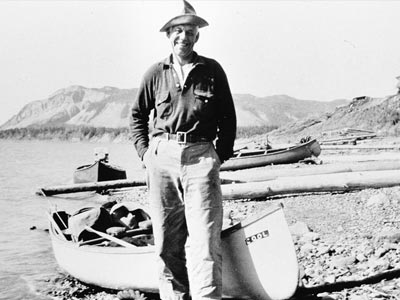 Sigurd F. Olson
Sigurd F. Olson
Sigurd F. Olson (1899 – 1982)
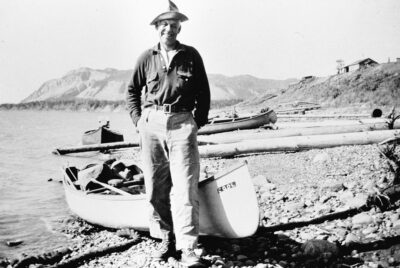 Without love of the land, conservation lacks meaning or purpose, for only in a deep and inherent feeling for the land can there be dedication in preserving it.
Without love of the land, conservation lacks meaning or purpose, for only in a deep and inherent feeling for the land can there be dedication in preserving it.
Sigurd Ferdinand “Sig” Olson is perhaps the most overlooked of the founders of modern conservation, which is surprising since his unflinching determination and powerful writing changed our relationship with protected lands, especially wilderness. Born in Chicago, Illinois and the son of a Swedish Baptist minister, Olson abandoned a career in academia at age 48 to pursue his passion for writing and conservation. Olson’s appreciation of nature came early, and his conservation principals were shaped by his experiences in the Quetico-Superior region of the U.S. and Canada. Olson helped draft the Wilderness Act, played key roles in the establishment of the Arctic National Wildlife Refuge, Boundary Waters Canoe Area Wilderness, Point Reyes National Seashore, Voyageurs National Park, and influenced the creation of over 80 additional wilderness areas within the U.S. and Canada. Olson authored nine books, receiving awards for many, including the John Burroughs Medal for nature writing. The year before his death, the U.S. Department of the Interior awarded him the Conservation Service Award, its highest civilian honor. True to his convictions, Olson declined to accept the honor due to recent Departmental decisions that negatively impacted Wilderness Areas and National Parks at the time.
This plaque was created by SUTL Cohort 35.
Photo Credit: Courtesy of the Olson family.
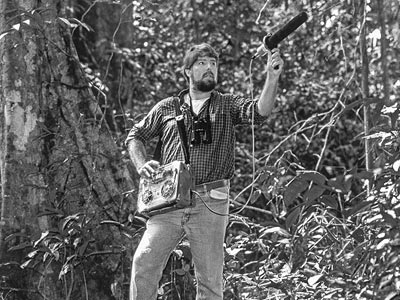 Theodore A. Parker III
Theodore A. Parker III
Theodore A. Parker III (1953-1993)
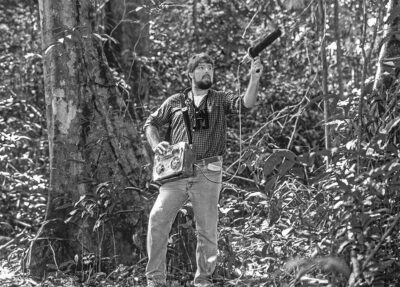 [Ted] had a 1-2-3 punch in terms of incredible work ethic, talent, and charisma. His ear for bird songs was extraordinary–he had an extra-planetary quality of hearing. [H]e really changed the face of ornithology … showing that unless you learn bird vocalizations, you are only at the tip of the iceberg in terms of studying them.
[Ted] had a 1-2-3 punch in terms of incredible work ethic, talent, and charisma. His ear for bird songs was extraordinary–he had an extra-planetary quality of hearing. [H]e really changed the face of ornithology … showing that unless you learn bird vocalizations, you are only at the tip of the iceberg in terms of studying them.
— Van Remsen, Curator of Birds at Louisiana State University’s Museum of Natural Science
Theodore “Ted” Parker III is regarded as one of the world’s best field ornithologists based on his pioneering use of sound as a tool for identifying birds. Parker was a passionate conservationist who was instrumental in conserving more than four million acres of tropical wilderness in South America that support upwards of 1,000 bird species. Parker began birding as a boy in Pennsylvania and set a North American record at 18 years old by observing 627 bird species in one year. Ted’s extraordinary ability to identify birds by sound was based on an encyclopedic knowledge of more than 4,000 species. Colleagues recognized him both as a genius who inspired countless ornithologists and graduate students around the world and a generous scientist who contributed more than 10,000 recordings to the Macaulay Library of Natural Sound at Cornell University. Parker played a key role in making audio recordings and field guides of South American birds accessible to the public. His work in the development of the Rapid Assessment Program with Conservation International show-cased the amazing biodiversity in South America and inspired global action to conserve vulnerable ecosystems. Parker built his career on field work and experiential learning in lieu of advanced academic degrees. He felt he didn’t have time for formal courses–he was too busy making a difference on the ground. When Tim Gallagher joined the staff of Living Bird magazine, he told Parker that he had taken the job as editor in the hope that he could do some good for wildlife conservation. Parker’s response was simply: “What are you waiting for?”
Photo Credit: Haroldo Castro.
This plaque was created by SUTL Cohort 37.
 Dr. Alan Rabinowitz
Dr. Alan Rabinowitz
Dr. Alan Rabinowitz (1953-2018)
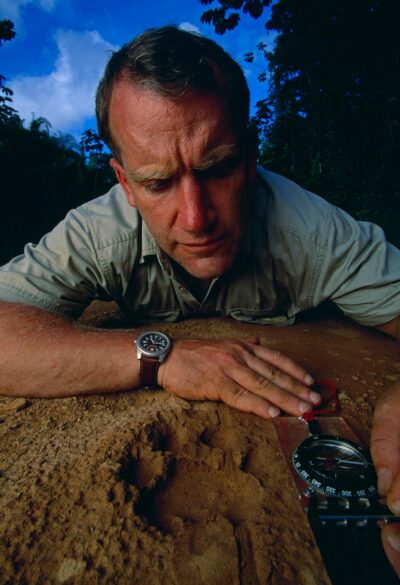 I don’t try to spend my life among a lot of human beings and I end up now more than ever at this point in my life being with people because that’s the way to save the world’s wildlife.
I don’t try to spend my life among a lot of human beings and I end up now more than ever at this point in my life being with people because that’s the way to save the world’s wildlife.
–Dr. Alan Rabinowitz
Dr. Alan Rabinowitz was an American zoologist, specializing in conservation of the world’s wild cat species and the wild places on which they rely. Suffering from a debilitating stutter as a child, Rabinowitz spent his days talking to the big cats at the Bronx Zoo. He vowed to be a “voice for the voiceless” and protect the wild cats he loved.
Following his Ph.D. in 1981, Rabinowitz worked for the Wildlife Conservation Society where he pioneered research on wild jaguars. In 1986, while working in Belize, Rabinowitz successfully petitioned the prime minister and his cabinet to establish the world’s first jaguar preserve, the Cockscomb Basin Jaguar Preserve. Combining scientific understanding with the ability to build key relationships enabled Rabinowitz to champion conservation efforts protecting wild cats across the globe. Throughout his career, he continued using this conservation model to help create at least seven preserves world-wide dedicated to the preservation of wildlife.
In 2006, Rabinowitz co-founded Panthera, the only non-profit organization dedicated to the conservation of the world’s 40 cat species. Over the next 10 years, Panthera created partnerships all over the world to combat illegal poaching, wildlife trafficking, and habitat destruction.
Rabinowitz began life challenged at speaking and ended a prolific communicator, authoring six books in addition to hundreds of articles and lectures. He taught that “we are all wildlife” and died believing that the future of the jaguar was bright because of “governments and people sharing their homes with this big cat.”
This plaque was created by SUTL Cohort 38.
Photo Credit: Steve Winter/Panthera.
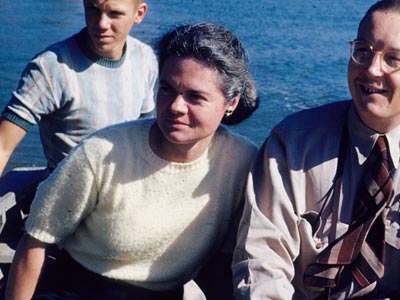 Lucille Farrier Stickel
Lucille Farrier Stickel
Lucille Farrier Stickel (1915-2007)
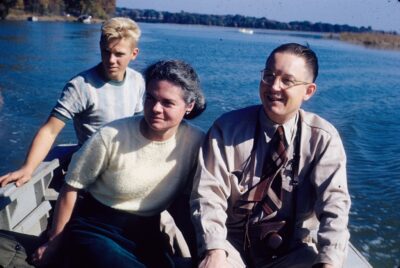 Dr. Lucille Farrier Stickel was born on January 11, 1915 in Hillman, Michigan where she first developed her love of all things nature. After pursuing biology for her bachelor’s and master’s degrees, Stickel’s secondary education culminated in a doctorate in zoology. Following graduation, Stickel worked as a junior biologist at USFWS Patuxent Wildlife Research Center where she began researching box turtle population dynamics. This research continues and is regarded as the longest continuous study of a wildlife species in North America.
Dr. Lucille Farrier Stickel was born on January 11, 1915 in Hillman, Michigan where she first developed her love of all things nature. After pursuing biology for her bachelor’s and master’s degrees, Stickel’s secondary education culminated in a doctorate in zoology. Following graduation, Stickel worked as a junior biologist at USFWS Patuxent Wildlife Research Center where she began researching box turtle population dynamics. This research continues and is regarded as the longest continuous study of a wildlife species in North America.
Stickel pioneered research techniques in evaluating the significance of pesticide residue in wildlife animals, as well as the transmission of these residues from animals to and through the food chain. Her discovery that dichloro-diphenyl-trichloroethane (DDT) caused population declines in birds gained worldwide recognition and led to the banning of DDT in 1972. The cause of eggshell thinning is considered one of the most significant findings ever published by Patuxent scientists. In 1973, Stickel became Director of the Patuxent Wildlife Research Center and served in the role for 8 years until her retirement. Stickel received many awards including the Department of the Interior’s Distinguished Service Award. Her legacy lives on through the accomplishments of the students she mentored and the prestige that the renamed Eastern Ecological Science Center still holds today.
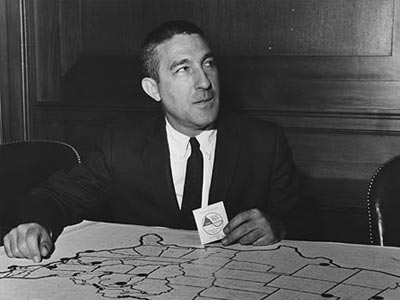 Stewart Lee Udall
Stewart Lee Udall
Stewart Lee Udall (1920 - 2010)
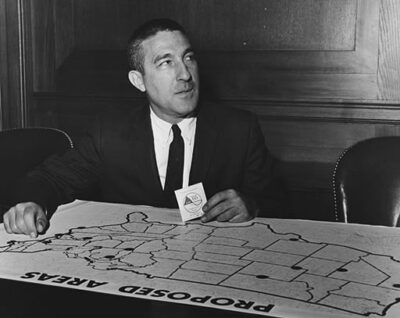 Plans to protect air and water, wilderness and wildlife, are in fact plans to protect man.
Plans to protect air and water, wilderness and wildlife, are in fact plans to protect man.
Stewart Udall was a visionary conservationist and a pioneer of the environmental movement. Udall served as a three term US Representative from Arizona and also as the Secretary of the Interior from 1961-1969 under Presidents John F. Kennedy and Lyndon B. Johnson. Under Udall’s leadership, the Department of the Interior was a beacon of conservation, wildland preservation, and environmental stewardship. Udall oversaw the addition of four national parks, six national monuments, eight national seashores and lakeshores, nine national recreation areas, twenty national historic sites, and fifty-six national wildlife refuges. He played a key role in developing and enacting major environmental protection laws, including the Clean Air Act, Water Quality Act, Clean Water Restoration Act, Wilderness Act of 1964, Endangered Species Preservation Act of 1966, Land and Water Conservation Fund Act of 1965, Solid Waste Disposal Act of 1965, National Trail System Act of 1968, and the Wild and Scenic Rivers Act of 1968. Udall also worked to support the cultural arts and was instrumental in promoting initiatives which led to the creation of the National Endowment of the Arts and the National Endowment for the Humanities. An accomplished writer, Udall authored the best-selling book, The Quiet Crisis (1963), which warned about the dangers of pollution, overuse of natural resources, and dwindling open spaces. In one of his final written works, “Letter to My Grandchildren” Udall lamented his generation’s misjudgments, expounded on the resource challenges facing us, and exhorted “his grandchildren” to face these challenges, while expressing hope for the future.
Credit: This plaque was created by SUTL Cohort 31.
Image Credit: National Park Service Historic Photograph Collection
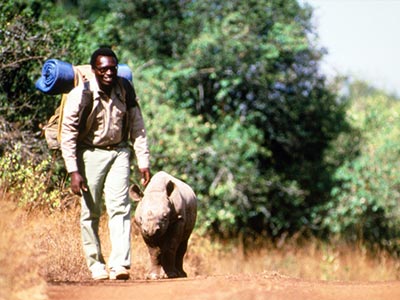 Michael Werikhe
Michael Werikhe
Michael Werikhe (1956-1999)
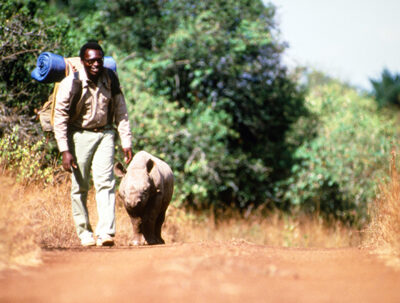 I got my degrees in the bush. You don’t have to have a degree to be a conservationist. You don’t have to be really well educated. All you need to do is ask yourself what you can do in order to improve the quality of life for all. I believe for conservation to have any impact, for conservation to work at any level in any given situation, you have to involve the ordinary people.
I got my degrees in the bush. You don’t have to have a degree to be a conservationist. You don’t have to be really well educated. All you need to do is ask yourself what you can do in order to improve the quality of life for all. I believe for conservation to have any impact, for conservation to work at any level in any given situation, you have to involve the ordinary people.
Weighing confiscated rhinoceros horns for a living troubled Michael Werikhe so much that he quit his job and asked himself what he could do to save this special animal. His answer, start walking. In 1982, Werikhe left his home in Mombasa, Kenya and walked more than 270 miles to Nairobi. He then walked through Uganda, Kenya, and Tanzania. By 1991, he had walked across Africa, Taiwan, five countries in Europe and 30 cities in North America, approximately 5,000 miles. Along the way, he talked with people about the black rhino, a species he considered emblematic of Africa’s conservation crisis. His walks increased awareness about the plight of the rhino and raised millions in funds, which were used to establish and support protected areas for rhinos in Kenya. A self-proclaimed ordinary man, armed with his “degrees from the bush,” Werikhe used the rhino to address larger issues affecting Africa and tied the success of the people to the existence of wildlife. He brought worldwide attention to rhino conservation and was the recipient of several international awards. Though honored by heads of state and royalty, his focus was always on ordinary people, as he believed strongly that the rhinos’ conservation must start with the people who live with them. Dubbed the Rhino Man, Werikhe felt a kinship to the rhino as both were “shy, sensitive and nearsighted.” Michael Werikhe showed how one person, armed with a deep passion and conviction, can use a simple act to inspire a conservation movement.
This plaque was created by SUTL Cohort 30.
Photo Credit: Goldman Environmental Prize
 Virginia “Ginny” Hill Wood
Virginia “Ginny” Hill Wood
Virginia “Ginny” Hill Wood (1917 – 2013)
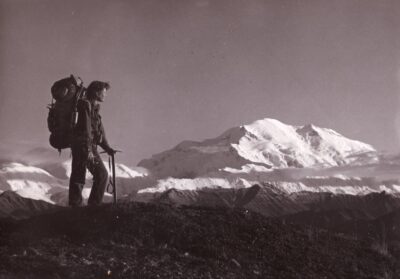 The wilderness that we have conquered and squandered in our conquest of new lands has produced the traditions of the pioneer that we want to think still prevail: freedom, opportunity, adventure, and resourceful, rugged individuals. These qualities can still be nurtured in generations of the future if we are farsighted and wise enough to set aside this wild country immediately, and spare it from the exploitations of a few for the lasting benefit of the many.
The wilderness that we have conquered and squandered in our conquest of new lands has produced the traditions of the pioneer that we want to think still prevail: freedom, opportunity, adventure, and resourceful, rugged individuals. These qualities can still be nurtured in generations of the future if we are farsighted and wise enough to set aside this wild country immediately, and spare it from the exploitations of a few for the lasting benefit of the many.
— Ginny Hill testimony to Congress (1960)
When Virginia “Ginny” Hill Wood landed her airplane in Fairbanks, Alaska in 1947, she confirmed her mother’s assertion that she was filled with wanderlust. Wood was an adventuresome person who worked on dude ranches as a teenager, taught herself to sail, and toured Europe by bicycle as a young adult. Never constrained by societal norms regarding women, Wood applied to and was accepted in the Civilian Pilot Training Program. During WWII, Wood served in the Women Airforce Service Pilots (WASPs), for which she received a Congressional Medal of Honor in 2009.
Wood met Celia Hunter while ferrying surplus planes after WWII. The two developed a friendship that lasted 50 years. Wood, her then-husband Morton “Woody” Wood, and Hunter established Camp Denali, Alaska’s first wilderness camp. Wood led visitors on backpacking, rafting, and canoeing adventures. In 1960, they founded the Alaska Conservation Society, Alaska’s first grassroots conservation organization. Wood and Hunter’s relentless letter writing campaign and ardent testimony to Congress were pivotal in the creation of the Arctic National Wildlife Refuge. Together, their efforts to protect Alaskan wilderness led to their being dubbed the “matriarchs of Alaska Conservation”.
Wood received numerous accolades and awards for her conservation efforts, including the U.S. Fish and Wildlife Service’s Citizen’s Award for her visionary involvement in establishing the Arctic National Wildlife Refuge. Above all, she believed in living sustainably and frugally to leave a small ecological footprint. Wood is remembered as a fun-loving person who lived a life full of passion and adventure.
This plaque was created by SUTL Cohort 33.
Photo Credit: Ginny Hill Wood hiking to McGonagall Pass in Denali National Park, 1961 doing what she loved best. Courtesy of Ginny Hill Wood’s private collection.
 Charles Young
Charles Young
Charles Young 1864-1922
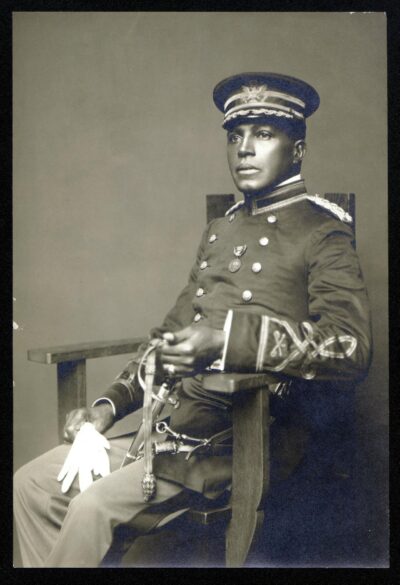 A journey through this park and the Sierra Forest Reserve to the Mount Whitney country will convince even the least thoughtful man of the needfulness of preserving these mountains just as they are, with their clothing of trees, shrubs, rocks, and vines, and of their importance to the valleys below as reservoirs for storage of water for agricultural and domestic purposes. In this, then, lies the necessity of forest preservation.
A journey through this park and the Sierra Forest Reserve to the Mount Whitney country will convince even the least thoughtful man of the needfulness of preserving these mountains just as they are, with their clothing of trees, shrubs, rocks, and vines, and of their importance to the valleys below as reservoirs for storage of water for agricultural and domestic purposes. In this, then, lies the necessity of forest preservation.
–Captain Charles Young, 9th Cavalry, Sequoia National Park, 1903
A leader among the legendary “Buffalo Soldiers,” Charles Young served in the segregated U.S. Army of the 19th and early 20th centuries. Born to former slaves during the Civil War, Young became one of the few black military officers at the time. He attended the United States Military Academy at West Point and, in 1889, became the third African American cadet to graduate and become an Army officer. Young served in the United States, Philippines, Haiti, Liberia, and Mexico during his 37 year military career. He commanded the 9th Cavalry, at that time one of four black regiments in the U.S. Army, known as “The Buffalo Soldiers.”
In 1903, Young became the first African American National Park Superintendent when he and his troops were tasked to manage and maintain what is now Sequoia and Kings Canyon National Parks. They constructed roads and trails that other troops were unable to complete before them. He and his troops also built the first trail to the summit of Mt. Whitney, erected fences around Sequoia trees, protected the parks from poachers, and prevented domestic sheep from grazing the parks’ meadows.
At the terminus of his career, Young had risen to Colonel, the highest rank held by an African American up to that time. In spite of overt racism and stifling inequality, Young rose through the military ranks to become one of the most respected leaders of his time. In 2013, President Barack Obama established the Charles Young Buffalo Soldiers National Monument, which includes Young’s former home in Wilberforce, Ohio.
This plaque was created by SUTL Cohort 36.
Photo courtesy of National Afro-American Museum & Cultural Center, Wilberforce, OH.

